
$-*."5&3&4*-*&/5"(3*$6-563&13"$5*$&4'03
4."--)0-%&3'"3.&3470-6.&1"35
'"3.&3)"/%0654&/(-*4)
77

Climate Resilient Agriculture:
Practices for Smallholder Farmers
Volume 2 part 5
Farmer Handouts: English
E Kruger, MC Dlamini, T Mathebula, P Ngcobo, BT Maimela & S Ntonta
Report to the
Water Research Commission
by
Mahlathini Development Foundation
WRC Report No. TT 841/6/20
February 2021

Obtainable from
Water Research Commission
Private Bag X03
Gezina, 0031
orders@wrc.org.za or download from www.wrc.org.za or www.mahlathini.org
The publication of this report emanates from a project entitled Collaborative knowledge creation and mediation
strategies for the dissemination of Water and Soil Conservation practices and Climate Smart Agriculture in
smallholder farming systems. (WRC Project No.K5/2719/4)
This report forms part of a series of 9 reports. The reports are:
Volume 1: Climate Change Adaptation for smallholder farmers in South Africa. An implementation and
decision support guide. Summary report. (WRC Report No. TT 841/1/20)
Volume 2 Part 1: Community Climate Change Adaptation facilitation: A manual for facilitation of Climate
Resilient Agriculture for smallholder farmers. (WRC Report No. TT 841/2/20)
Volume 2 Part 2: Climate Resilient Agriculture. An implementation and support guide: Intensive homestead
food production practices. (WRC Report No. TT 841/3/20)
Volume 2 Part 3: Climate Resilient Agriculture. An implementation and support guide: Local, group-based
access to water for household food production. (WRC Report No. TT 841/4/20)
Volume 2 Part 4: Climate Resilient Agriculture. An implementation and support guide: Field cropping and
livestock integration practices. (WRC Report No. TT 841/5/20)
Volume 2 Part 5: Climate Resilient Agriculture learning materials for smallholder farmers in English. (WRC
Report No. TT 841/6/20)
Volume 2 Part 6: Climate Resilient Agriculture learning materials for smallholder farmers in isiXhosa. (WRC
Report No. TT 841/7/20)
Volume 2 Part 7: Climate Resilient Agriculture learning materials for smallholder farmers in isiZulu. (WRC
Report No. TT 841/8/20)
Volume 2 Part 8: Climate Resilient Agriculture learning materials for smallholder farmers in Sepedi. (WRC
Report No. TT 841/9/20)
DISCLAIMER
This report has been reviewed by the Water Research Commission (WRC) and approved for publication.
Approval does not signify that the contents necessarily reflect the views and policies of the WRC, nor does
mention of trade names or commercial productsconstitute endorsement or recommendation for use.
ISBN 978-0-6392-0232-7
Printed in the Republic of South Africa
© WATER RESEARCH COMMISSION

ACKNOWLEDGEMENTS
The following individuals and organisations deserve acknowledgement for their invaluable contributions and
support to this project:
Chris Stimie (Rural Integrated Engineering – RIEng)
Dr Brigid Letty and Jon McCosh (Institute of Natural Resources – INR)
Nqe Dlamini (StratAct)
Catherine van den Hoof (Researcher)
Dr Sharon Pollard, Ancois de Villiers, Bigboy Mkabela and Derick du Toit (Association for Water and Rural
Development)
Hendrik Smith (GrainSA)
Marna de Lange (Socio-Technical Interfacing)
Matthew Evans (Web developer)
MDF interns and students: Khethiwe Mthethwa, Samukhelisiwe Mkhize, Sylvester Selala, Palesa Motaung
and Sanelise Tafa
MDF board members: Timothy Houghton and Desiree Manicom
PROJECT FUNDED BY
REFERENCE GROUP MEMBERS
Prof S Mpandeli Water Research Commission
Dr S Hlophe-Ginindza Water Research Commission
Dr L NhamoWater Research Commission
Dr O CrespoUniversity of Cape Town
Dr A Manson KZN Department of Agriculture and Rural Development
Prof S WalkerAgricultural Research Council
Prof CJ Rautenbach Previously of WeatherSA
COLLABORATING ORGANISATIONS
https://inr.org.za/https://award.org.za/https://amanziforfood.co.za/
https://foodtunnel.co.za/http://www.rieng.co.za/

This page was intentionally left blank
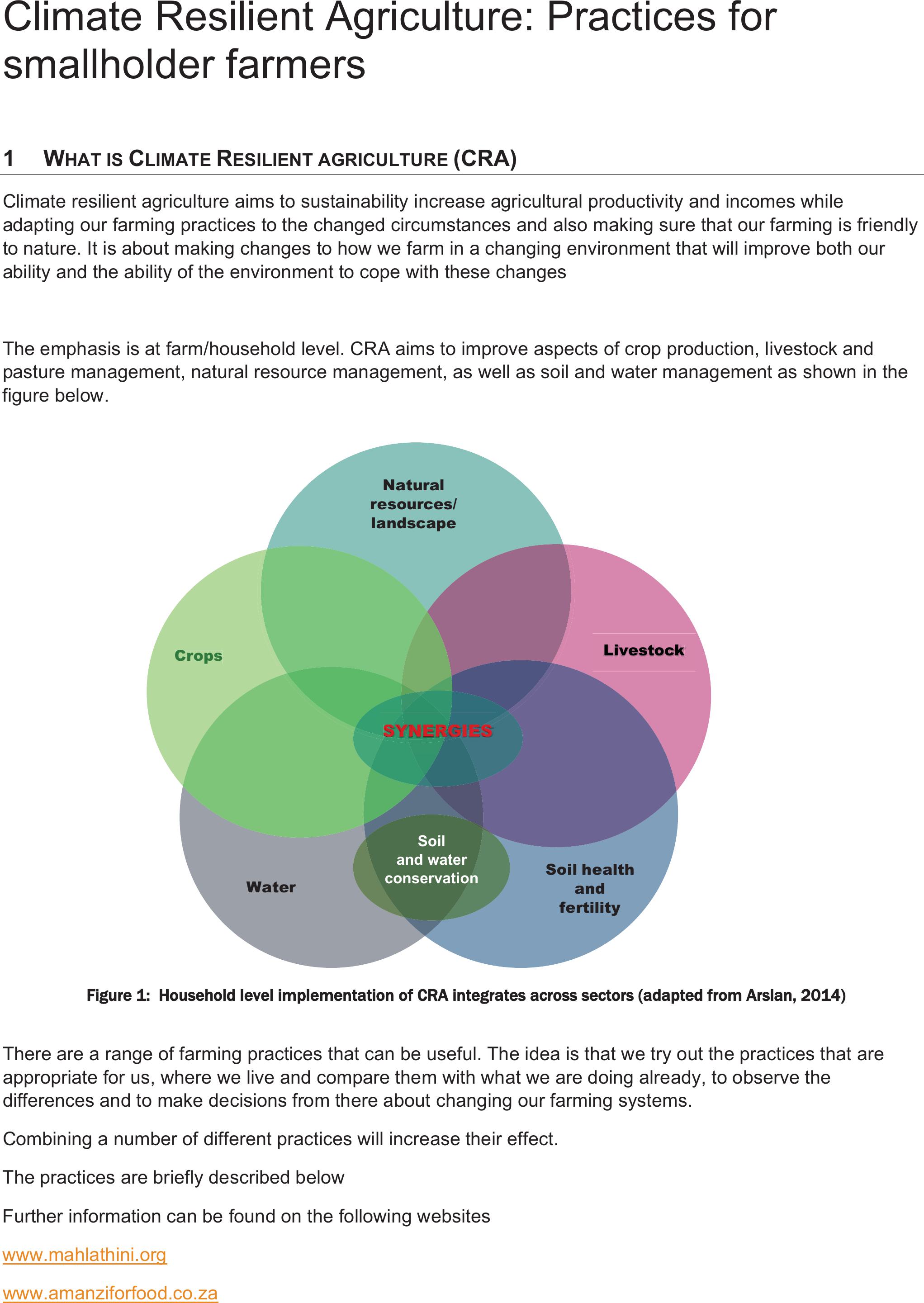
Climate Resilient Agriculture: Practices for
smallholder farmers
1 WHAT IS CLIMATE RESILIENT AGRICULTURE (CRA)
Climate resilient agriculture aims to sustainability increase agricultural productivity and incomes while
adapting our farming practices to the changed circumstances and also making sure that our farming is friendly
to nature. It is about making changes to how we farm in a changing environment that will improve both our
ability and the ability of the environment to cope with these changes
The emphasis is at farm/household level. CRA aims to improve aspects of crop production, livestock and
pasture management, natural resource management, as well as soil and water management as shown in the
figure below.
Figure 1: Household level implementation of CRA integrates across sectors (adapted from Arslan, 2014)
There are a range of farming practices that can be useful. The idea is that we try out the practices that are
appropriate for us, where we live and compare them with what we are doing already, to observe the
differences and to make decisions from there aboutchanging our farming systems.
Combining a number of different practices will increase their effect.
The practices are briefly described below
Further information can be found on the following websites
www.mahlathini.org
www.amanziforfood.co.za
Crops Livestock
Li
v
e
st
oc
k
Soil health
and
fertility
Water
C
rops
Natural
resources/
landscape
SYNERGIES
S
S
S
S
S
S
S
S
S
S
S
S
S
S
S
S
S
S
S
S
S
SY
SY
SY
SY
SY
SY
SY
SY
SY
SY
SY
SY
S
S
S
S
S
S
S
S
S
SY
S
S
S
S
S
S
S
S
S
S
S
S
S
Y
Y
Y
Y
Y
Y
Y
Y
Y
N
N
NN
N
N
N
N
N
N
N
N
N
E
E
E
E
EE
E
E
E
E
E
E
E
E
E
E
E
E
G
IE
IE
IE
IE
IE
IE
IE
IE
E
E
IE
I
E
IE
S
SSS
S
S
S
S
S
S
S
S
S
S
S
S
S
S
S
S
S
S
S
S
S
S
G
G
G
G
G
G
G
G
G
G
G
G
G
G
G
G
IE
IE
IE
IE
E
E
E
E
S
S
S
S
G
G
G
G
G
G
G
G
G
G
G
G
IE
IE
IE
IE
E
I
IE
E
IE
E
E
E
E
S
S
S
S
S
S
S
S
S
S
G
RG
RG
RG
RG
RG
RG
RG
RG
RG
G
RG
RG
G
R
G
R
RG
RG
G
G
RG
RG
G
RG
RG
G
G
G
G
RG
G
G
RG
R
R
R
R
R
R
R
R
R
R
R
R
R
R
R
R
R
R
R
R
R
R
R
Soil
and water
conservation

2 PRINCIPLES
The main principles or concepts that we have focused on in choosing the practices are the following:
• Minimize external inputs
• Maximise internaldiversity
• Focus on soil health and natural soil building techniques
• Take care of the environment
• Use available water as efficiently as possible.
• Work together, learn together and plan together
All these practices have been tried out with smallholder farmers over the last three to eight years. We know
they work, so good luck with trying them all out.
3 WATER MANAGEMENT (MANAGE AVAILABLE WATER AND INCREASE ACCESS TO WATER)
3.1 INFILTRATION DITCHES (RUN-ON DITCHES, DIVERSION DITCHES)
These are shallow ditches (30 cm wide and 15-30 cm deep) that are dug either to channel water to a specific
area (diversion ditches) or to catch water an allow it to sink into the soil in a cropping area (run-on ditches);
the latter are dug on contour.
Planting can be done on the ridges, adding manure/ compost and mulching of both the ridges and ditches is a
good idea
These ditches increase access to and availability of water in intensive food production.
REQUIREMENTS
- Rainfall: >150 mm/year
- Temperature: >5°C
-Topography: any slope
-Soil: 5-35% clay, depth >15 cm
-
IMPLEMENTATION
- Gardens, fields
- <0,1 ha, 0,1-1 ha
-Low cost, local resources
-Easy to do and maintain; labour intensive
Diversion ditch, mulched and
sweet potato planted on
ridge
Digging a diversion ditch (1,5-5%slope; 30 cm wide
and 30 cm deep with soil placed on upper slope
Preparing the ridge of the diversion ditch for
planting – shaping and adding manure
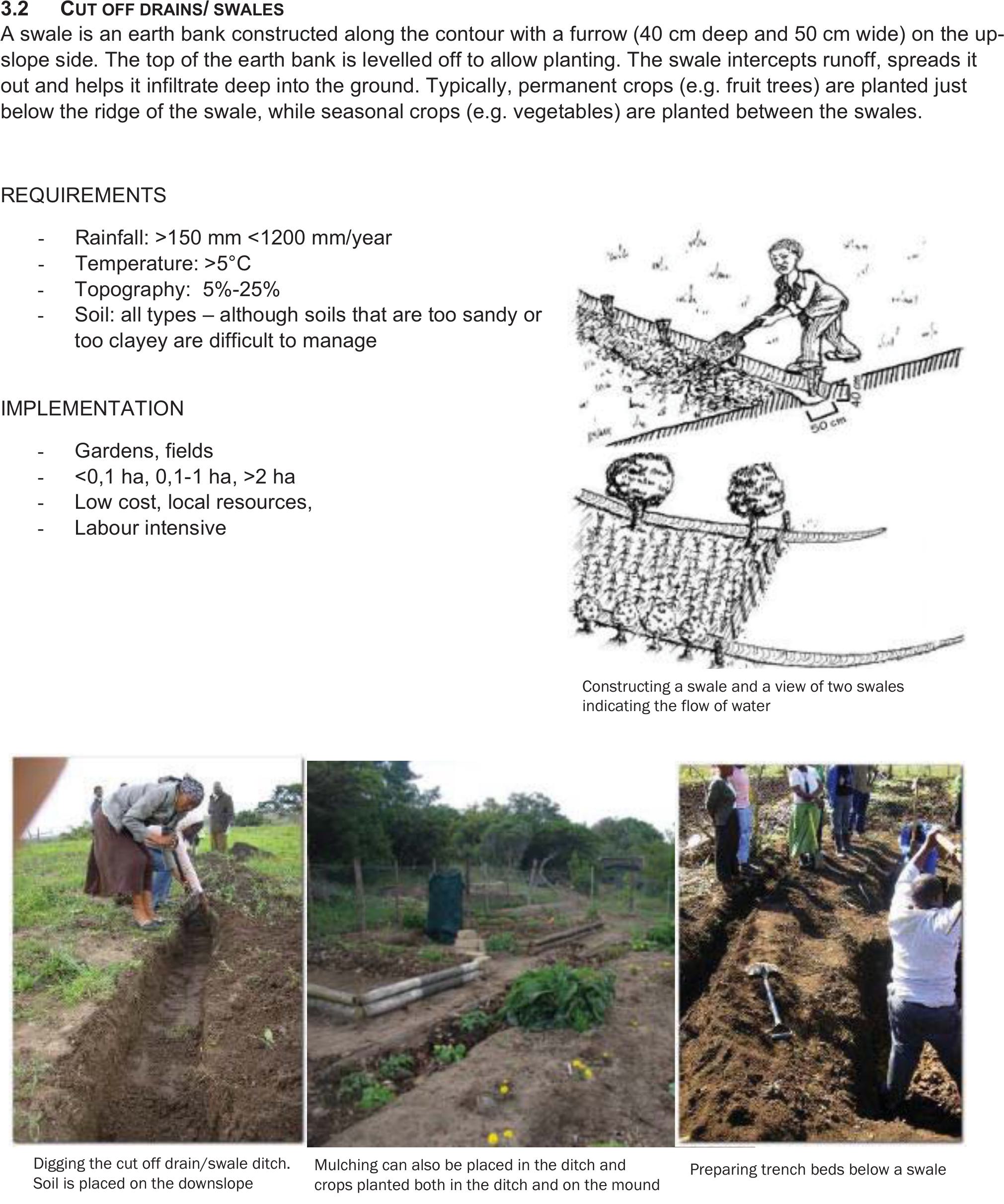
3.2 CUT OFF DRAINS/ SWALES
A swale is an earth bank constructed along the contour with a furrow (40 cm deep and 50 cm wide) on the up-
slope side. The top of the earth bank is levelled off to allow planting. The swale intercepts runoff, spreads it
out and helps it infiltrate deep into the ground. Typically, permanent crops (e.g. fruit trees) are planted just
below the ridge of the swale, while seasonal crops (e.g. vegetables) are planted between the swales.
REQUIREMENTS
-Rainfall: >150 mm <1200 mm/year
- Temperature: >5°C
- Topography: 5%-25%
-Soil: all types – although soils that are too sandy or
too clayey are difficult to manage
IMPLEMENTATION
- Gardens, fields
-<0,1 ha, 0,1-1 ha, >2 ha
-Low cost, local resources,
- Labour intensive
Constructing a swale and a view of two swales
indicating the flow of water
Digging the cut off drain/swale ditch.
Soil is placed on the downslope
Mulching can also be placed in the ditch and
cro
p
s
p
lanted both in the ditch and on the mound
Preparing trench beds below a swale
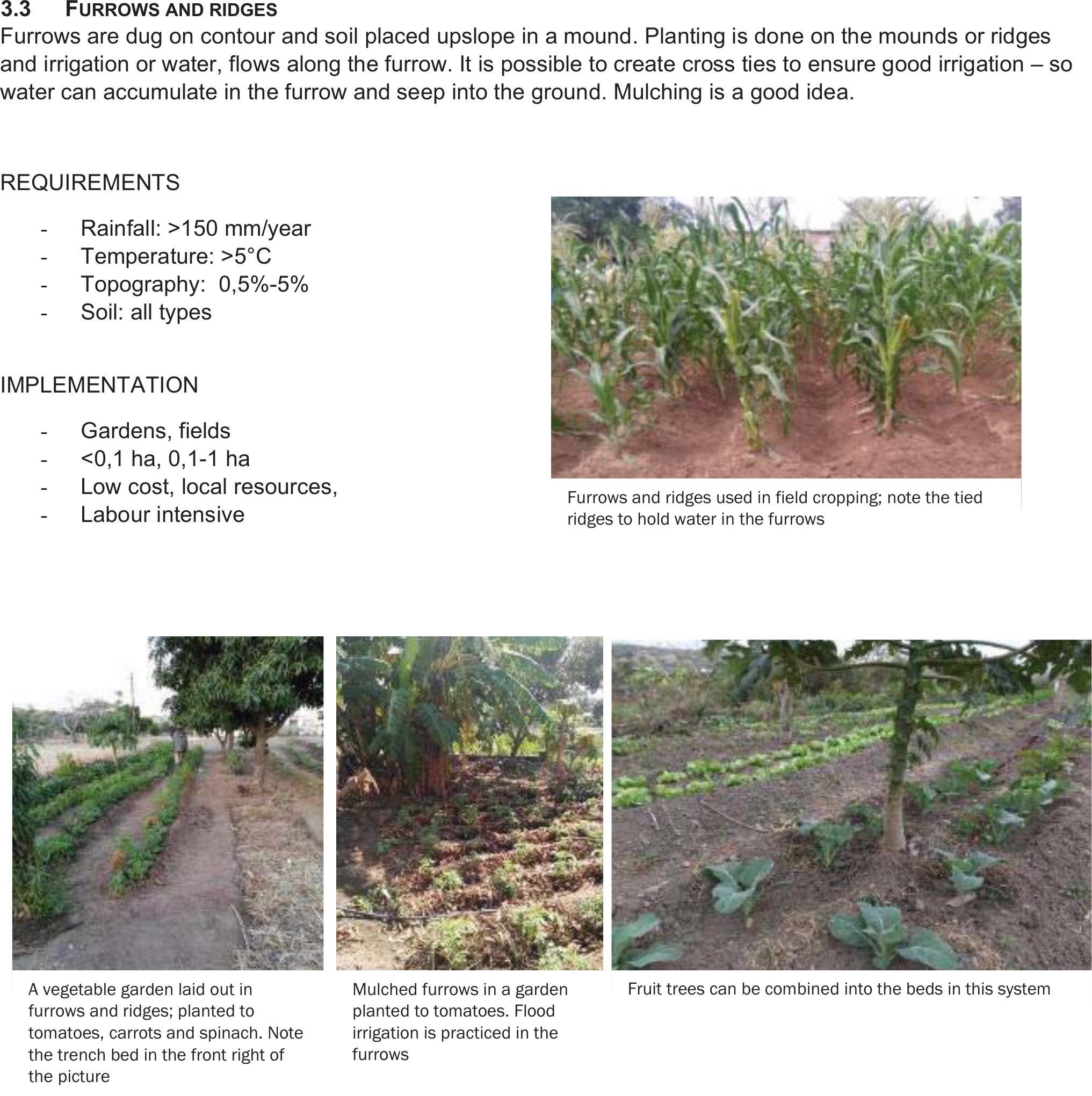
3.3 FURROWS AND RIDGES
Furrows are dug on contour and soil placed upslope in a mound. Planting is done on the mounds or ridges
and irrigation or water, flows along the furrow. It is possible to create cross ties to ensure good irrigation – so
water can accumulate in the furrow and seep into the ground. Mulching is a good idea.
REQUIREMENTS
- Rainfall: >150 mm/year
- Temperature: >5°C
- Topography: 0,5%-5%
- Soil: all types
IMPLEMENTATION
- Gardens, fields
-<0,1 ha, 0,1-1 ha
-Low cost, local resources,
- Labour intensive
Furrows and ridges used in field cropping; note the tied
ridges to hold water in the furrows
A vegetable garden laid out in
furrows and ridges; planted to
tomatoes, carrots and spinach. Note
the trench bed in the front right of
the picture
Mulched furrows in a garden
planted to tomatoes. Flood
irrigation is practiced in the
furrows
Fruit trees can be combined into the beds in this system
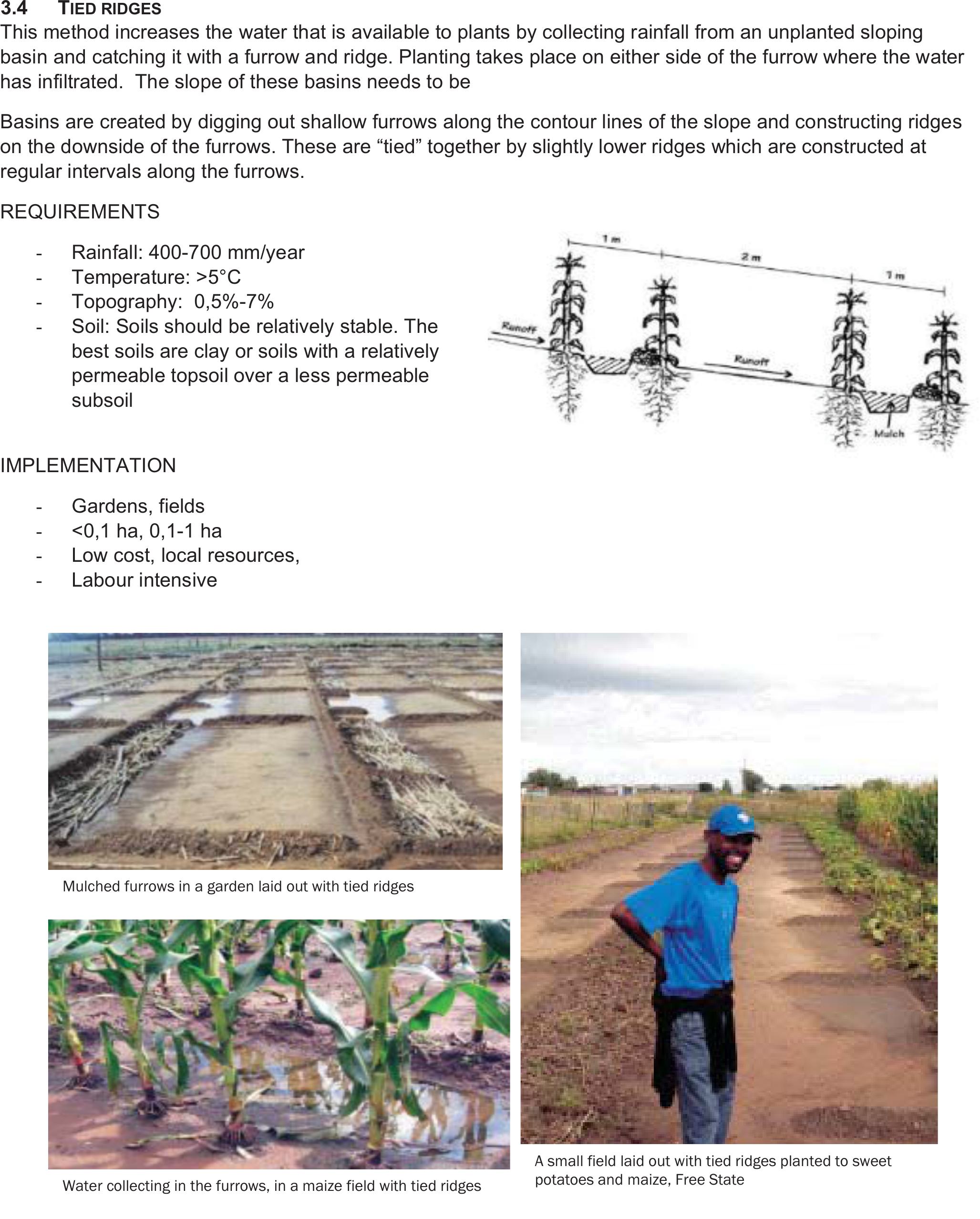
3.4 TIED RIDGES
This method increases the water that is available to plants by collecting rainfall from an unplanted sloping
basin and catching it with a furrow and ridge. Planting takes place on either side of the furrow where the water
has infiltrated. The slope of these basins needs to be
Basins are created by digging out shallow furrows along the contour lines of the slope and constructing ridges
on the downside of the furrows. These are “tied” together by slightly lower ridges which are constructed at
regular intervals along the furrows.
REQUIREMENTS
- Rainfall: 400-700 mm/year
- Temperature: >5°C
- Topography: 0,5%-7%
-Soil: Soils should be relatively stable. The
best soils are clay or soils with a relatively
permeable topsoil over a less permeable
subsoil
IMPLEMENTATION
- Gardens, fields
-<0,1 ha, 0,1-1 ha
-Low cost, local resources,
- Labour intensive
Mulched furrows in a garden laid out with tied ridges
Water collecting in the furrows, in a maize field with tied ridges
A small field laid out with tied ridges planted to sweet
potatoes and maize, Free State

3.5 INFILTRATION PITS/ BANANA CIRCLES
Basins are dug in the soil along water flow lines (to catch and slow water). These basins are filled with organic
matter (large amounts) mixed with soil and bananas or other water loving crops are planted in the basins
A variation of this is that one pit or basin is dug in a water flow line and slowly filled with organic matter (green
and manure) – for slow composting. Here bananas or other crops are planted on the edges.
REQUIREMENTS
- Rainfall: >350 mm/year
- Temperature: >5°C
-Topography: 1,5%-25%
-Soil: all types (5-30% clay) and depths (>30 cm)
IMPLEMENTATION
- Gardens
- <0,1 ha,
-Low cost, local resources
-Easy to do and maintain; labour intensive
Smaller, separate basins can be
made; basins are dug out and filled
with or
g
anic matter
A mulched banana circle, mixed with herbsStep wise basins along a drainage line in a homestead garden.
Tied ridges are made between the basins
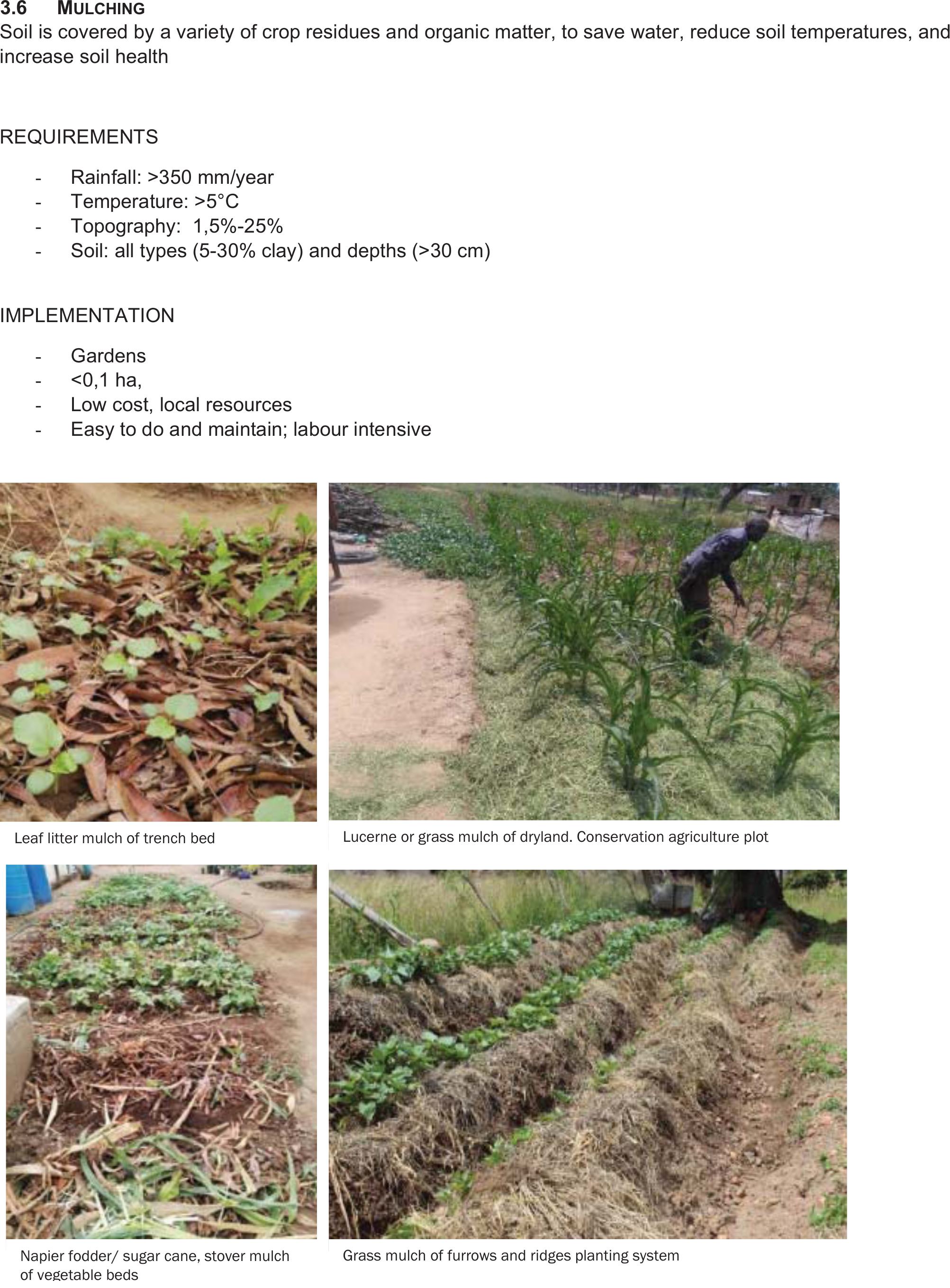
3.6 MULCHING
Soil is covered by a variety of crop residues and organic matter, to save water, reduce soil temperatures, and
increase soil health
REQUIREMENTS
- Rainfall: >350 mm/year
- Temperature: >5°C
- Topography: 1,5%-25%
-Soil: all types (5-30% clay) and depths (>30 cm)
IMPLEMENTATION
- Gardens
- <0,1 ha,
-Low cost, local resources
-Easy to do and maintain; labour intensive
Leaf litter mulch of trench bed
Napier fodder/ sugar cane, stover mulch
of ve
g
etable beds
Lucerne or grass mulch of dryland. Conservation agriculture plot
Grass mulch of furrows and ridges planting system
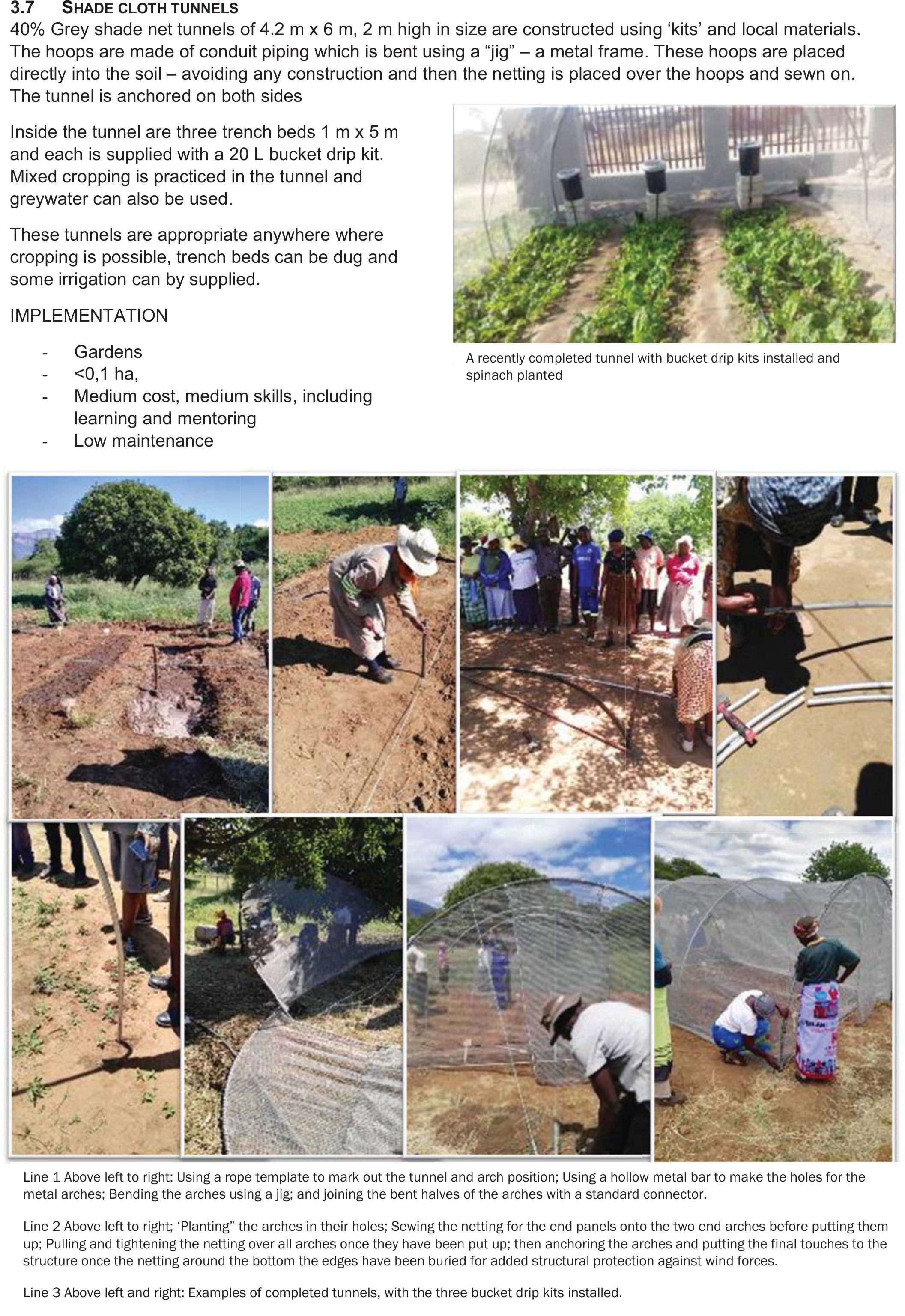
3.7 SHADE CLOTH TUNNELS
40% Grey shade net tunnels of 4.2 m x 6 m, 2 m high in size are constructed using ‘kits’ and local materials.
The hoops are made of conduit piping which is bent using a “jig” – a metal frame. These hoops are placed
directly into the soil – avoiding any construction and then the netting is placed over the hoops and sewn on.
The tunnel is anchored on both sides
Inside the tunnel are three trench beds 1 m x 5 m
and each is supplied with a 20 L bucket drip kit.
Mixed cropping is practiced in the tunnel and
greywater can also be used.
These tunnels are appropriate anywhere where
cropping is possible, trench beds can be dug and
some irrigation can by supplied.
IMPLEMENTATION
- Gardens
- <0,1 ha,
-Medium cost, medium skills, including
learning and mentoring
- Low maintenance
Line 1 Above left to right: Using a rope template to mark out the tunnel and arch position; Using a hollow metal bar to make the holes for the
metal arches; Bending the arches using a jig; and joining the bent halves of the arches with a standard connector.
Line 2 Above left to right; ‘Planting” the arches in their holes; Sewing the netting for the end panels onto the two end arches before putting them
up; Pulling and tightening the netting over all arches once they have been put up; then anchoring the arches and putting the final touches to the
structure once the netting around the bottom the edges have been buried for added structural protection against wind forces.
Line 3 Above left and right: Examples of completed tunnels, with the three bucket drip kits installed.
A recently completed tunnel with bucket drip kits installed and
spinach planted

3.8 RAINWATER HARVESTING AND STORAGE
Generally, smallholders
collect water in available
basins, drums and JoJo
tanks. This does not provide
a lot of water.
Underground tanks can store
a lot more water. These
tanks collect runoff water
form structures, roads and
the general area, to store
large amounts of water
(25 000-40 000 litres);
enough water for a 100-200
m2 garden for 4-6 months.
Large holes need to be dug and then tanks are constructed – either ferrocement, blocks and plaster or
geofabric and bitumen.
REQUIREMENTS
- Rainfall: >450 mm/year
- Temperature: >5°C
-Topography: 1,5%-25%
-Soil: all types (5-30% clay), and depths (>30 cm)
IMPLEMENTATION
- Gardens
-<0,1 ha, 0,1-1 ha, .2 ha
-High cost and or high labour requirements for storage structures
-High levels of skill and knowledge (outside support and training initially required
-Medium maintenance and effort. Water needs to be taken out by bucket, or pumped. Silt needs to be
removed from time to time
Local RWH storage options in Limpopo; basins, 210 L drums, 1000 L containers and Jo-Jo tanks,
these hold little water
A ferrocement underground tank with brick
wall for placement of a roof structure under
construction
An example of an underground tank (18 m3),
with a removable metal roof
(
Acornhoek
)
.
The silt trap for a 25 000 L underground
tank to reduce silt load of stored water
A completed geofabric tank with brick wall
and roof for safety. The inlet furrow for
water is in the foreground
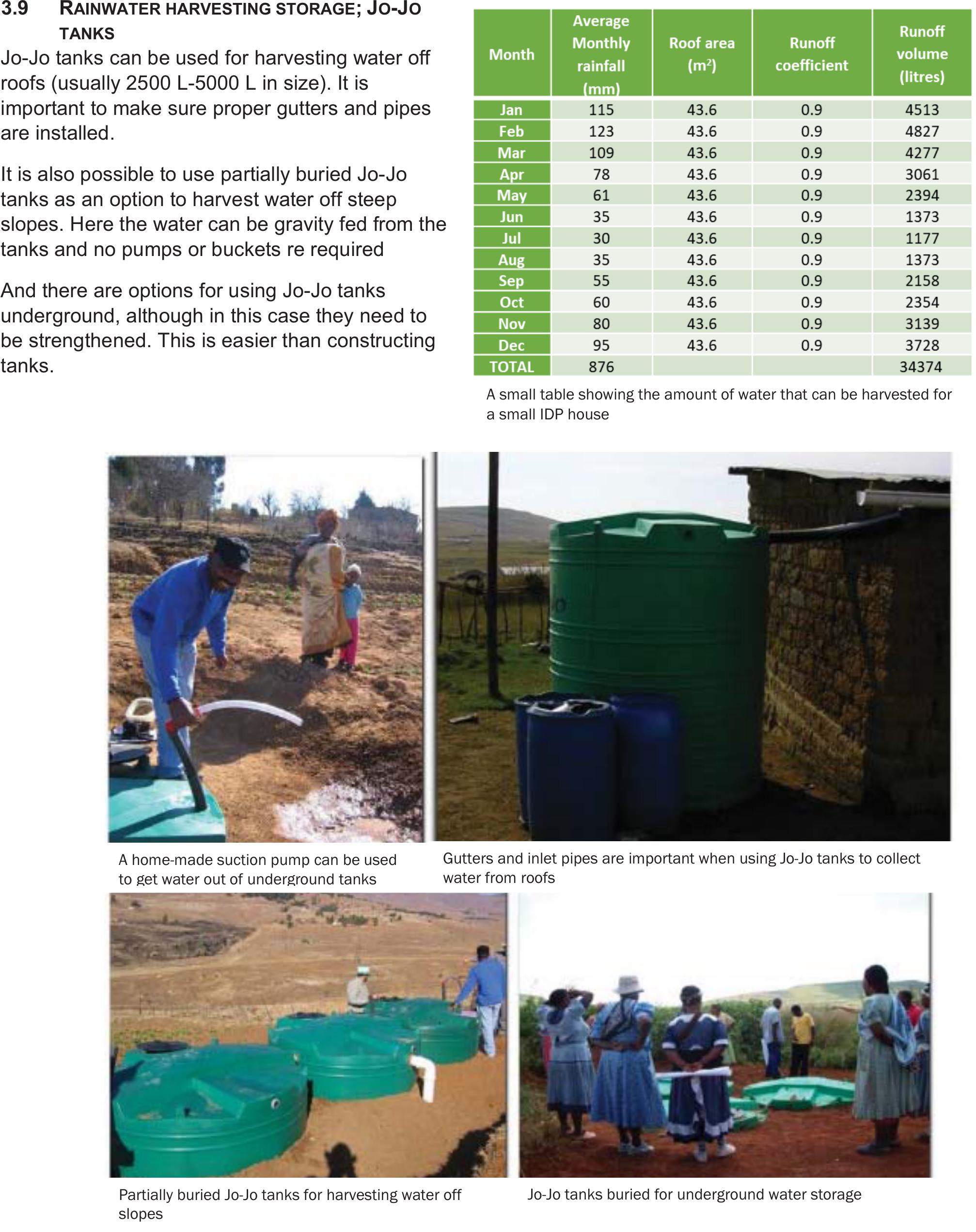
3.9 RAINWATER HARVESTING STORAGE;JO-JO
TANKS
Jo-Jo tanks can be used for harvesting water off
roofs (usually 2500 L-5000 L in size). It is
important to make sure proper gutters and pipes
are installed.
It is also possible to use partially buried Jo-Jo
tanks as an option to harvest water off steep
slopes. Here the water can be gravity fed from the
tanks and no pumps or buckets re required
And there are options for using Jo-Jo tanks
underground, although in this case they need to
be strengthened. This is easier than constructing
tanks.
A home-made suction pump can be used
to
g
et water out of under
g
round tanks
Gutters and inlet pipes are important when using Jo-Jo tanks to collect
water from roofs
Partially buried Jo-Jo tanks for harvesting water off
slopes
Jo-Jo tanks buried for underground water storage
A small table showing the amount of water that can be harvested for
a small IDP house

3.10 SMALL DAMS
Small dams can be dug in soils that can hold water (more than 25% clay). They tend to lose water and only
stay full for a short period, but provide a lot of water to the soil profile in the area. Usually they are dug in
places where small springs can fill them up on a continuous basis, or where overland water flow or run-off is
prevalent.
It is possible to line these small dams/ponds with plastic, but only if there is a reasonable chance that they will
stay full, as the plastic decays easily in the sun.
It is also possible to line the small dams with bentonite to seal them, again only when ponds are likely to
remain full of water most of the time.
Three examples of small dams/ponds dug in soil that will hold water – >25% clay to be sure. The one on the right is a ‘large’ dam fed
b
y
a s
p
rin
g
sli
g
htl
y
hi
g
her u
p
the slo
p
e. The dam in the central
p
icture is fed b
y
a
p
i
p
e
g
ravit
y
fed from a river
A small pond lined with bentonite (the yellowish clay inside the
pond,) being filled up. Note the angle of the pond walls, the
slope of the pond walls, that allows for the bentonite to be
stamped into sides and bottom of the pond to seal it.
A small pond dug in a community garden fed by run-off water
from the road and lined with plastic

3.11 WATER ACCESS
Management, and development of local water sources, with reticulation to homesteads and gardens is
possible for small local community groups:
-Community level groups work together to agree upon who will be involved (not more than 20 people),
who need to be actively involved in farming and in close proximity to each other
-They identify a local water source in the vicinity; a spring or potential borehole sites and ratify their
use of this source with the local authorities
-Then a system is designed to provide for a header tank filled from the source and then gravity fed
reticulation to all the involved households and gardens.
-The water committee designs and implements the rules for water allocations to each household and
manages any finances and payment involved
-All participating members are expected to contribute financially, to do the labour for the installations
themselves and to proactively manage the water with the other members in their group
-All permissions from the water services authorities and local authorities need to be obtained and
arrangements need to be made for ongoing maintenance.
REQUIREMENTS
- Rainfall: >150 mm/year
- Temperature: >5°C
-Topography: any slope
- Soils: Any
-Sources of water; springs, ground water
IMPLEMENTATION
Households and gardens
- <0,1 ha
-High cost, external and local resources
-Labour and skill intensive; need for local training and technical support
An example of a header tank
from where water is gravity fed
to the households
An example of a household
connection. These drums are
interlinked and have a float valve
to ensure the water stops
running when the drums are full
Drilling of boreholes and laying of pipes form the
header tank to the households
A spring dug out to form a small dam. The spring protection consists of a slotted pipe buried in a ditch dug below the dam and which
is then covered with gravel, shade netting and soil, to be protected. In this way a spring can be protected, without major construction

3.12 GREYWATER MANAGEMENT
Greywater is water used for washing in a household (clothes, dishes, people), but does not include blackwater
(toilet water, sewage). Greywater is generally high in soap content of various types and organic matter.
Dangers in use include microbial contamination, nitrification from soap and crusting on top of the soil if it is
used in the same place often. Management for safe use and disposal of greywater is important. Mostly this
consists of using ash and other substances such as moringa seed to bind and flocculate some of the soap,
and irrigation practices that avoids the greywater from touching the leaves of the crops.
Three methods for using grey water are described here.
1.Bucket drip kits
These are small drip irrigation systems made for individual beds, around 1 m wide and 5 m long and a 20 L
bucket. The drip kit is assembled on site making your own string drippers and choosing width of lines and
spacing of drippers. Usually two dripper lines are used; 30 cm apart. Watering is done on a daily basis.
These buckets can also be adapted to include sand filters to filter greywater and or dirty warty irrigation water.
In this case a layer of gravel is placed in the bottom of the bucket, followed by a layer of rinsed, clean river
sand. The sand is placed inside a muslin bag to avoid mixing when the buckets are filled with water. These
‘filters’ need to be replaced from time to time as the flowrate from the bucket drip systems starts slowing
down. The drip irrigation pipes also need to be ‘flushed’ by opening the end clamps and allowing the flow of
water to wash out any accumulated silt and debris
Gravel la
y
er in the bottom of the bucket
Sand placed in a closed muslin bag on-top of
the gravel, to avoid sand being washed into
the dri
pp
er lines
Wetting circles produced by the string
dri
pp
ers
Example of the two drip lines, 30 cm
apart Gre
y
water in a bucket dri
p
s
y
stem
Both the gravel and sand is rinsed prior to use,
to make sure they are clean and to avoid
clogging up of the system 2015)
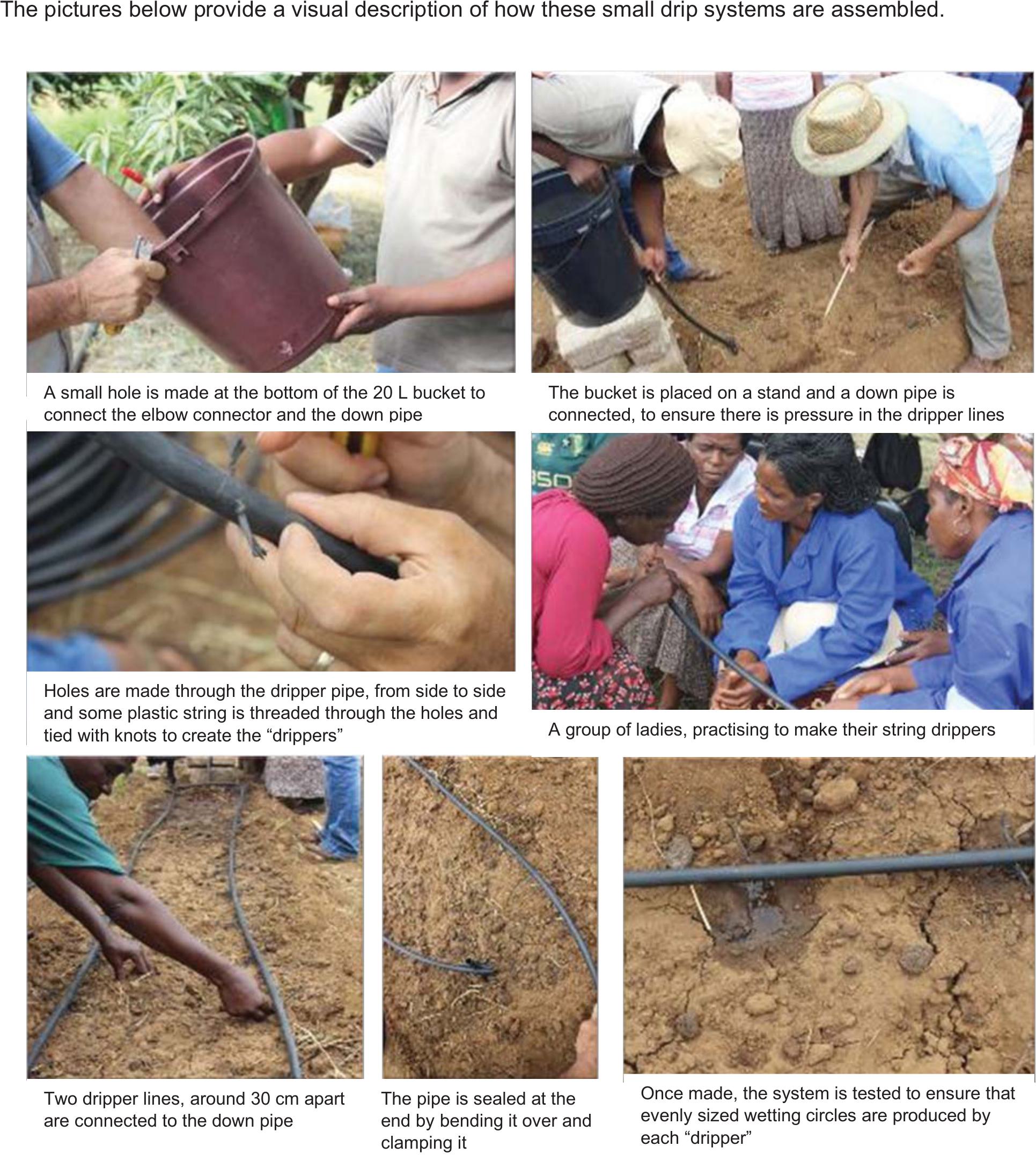
The pictures below provide a visual description of how these small drip systems are assembled.
The pipe is sealed at the
end by bending it over and
clam
p
in
g
it
Two dripper lines, around 30 cm apart
are connected to the down pipe
A group of ladies, practising to make their string drippers
Holes are made through the dripper pipe, from side to side
and some plastic string is threaded through the holes and
tied with knots to create the “dri
pp
ers”
A small hole is made at the bottom of the 20 L bucket to
connect the elbow connector and the down
p
i
p
e
The bucket is placed on a stand and a down pipe is
connected, to ensure there is
p
ressure in the dri
pp
er lines
Once made, the system is tested to ensure that
evenly sized wetting circles are produced by
each “dri
pp
er”
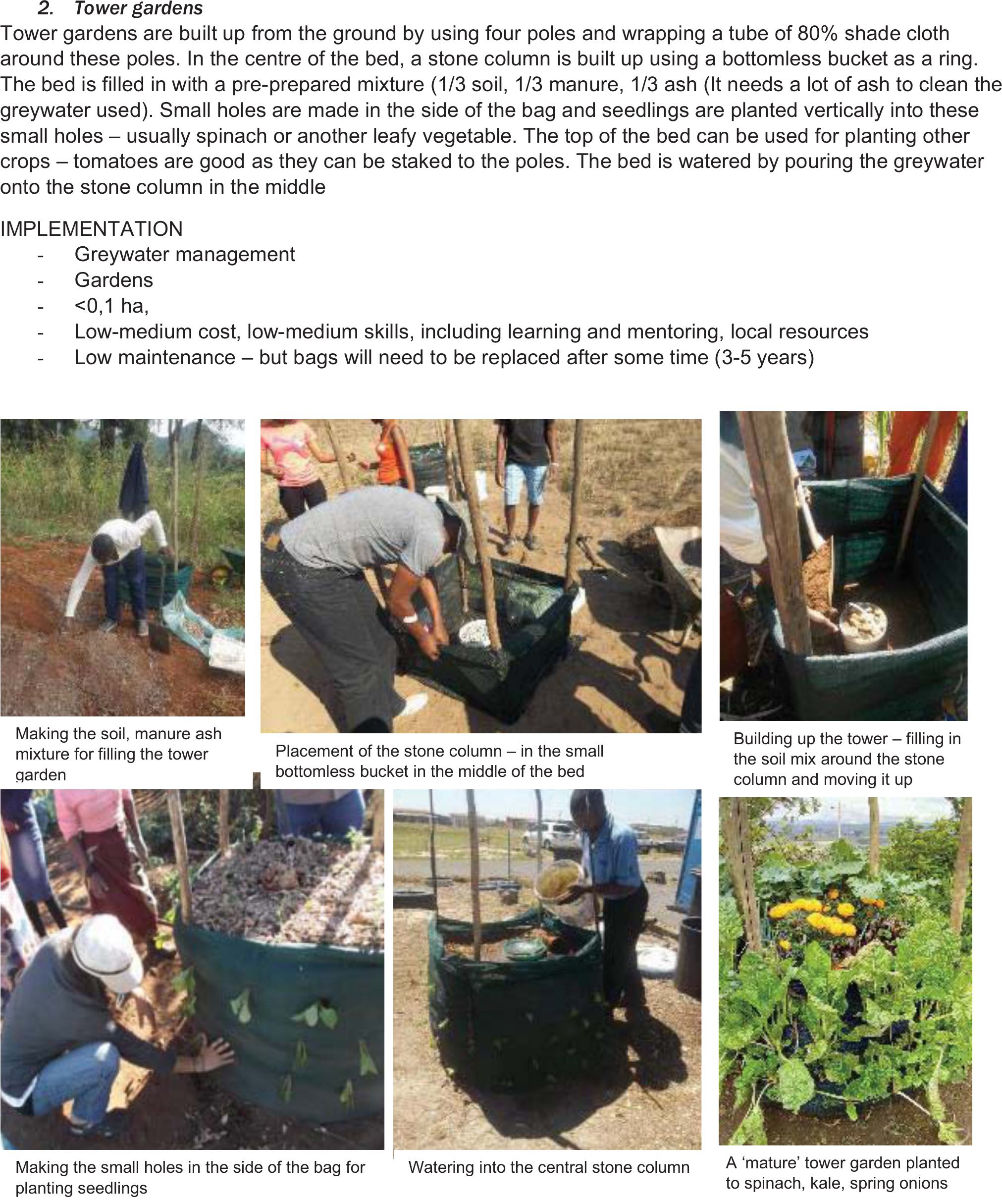
2.Tower gardens
Tower gardens are built up from the ground by using four poles and wrapping a tube of 80% shade cloth
around these poles. In the centre of the bed, a stone column is built up using a bottomless bucket as a ring.
The bed is filled in with a pre-prepared mixture (1/3 soil, 1/3 manure, 1/3 ash (It needs a lot of ash to clean the
greywater used). Small holes are made in the side of the bag and seedlings are planted vertically into these
small holes – usually spinach or another leafy vegetable. The top of the bed can be used for planting other
crops – tomatoes are good as they can be staked to the poles. The bed is watered by pouring the greywater
onto the stone column in the middle
IMPLEMENTATION
- Greywatermanagement
- Gardens
- <0,1 ha,
-Low-medium cost, low-medium skills, including learning and mentoring, local resources
-Low maintenance – but bags will need to be replaced after some time (3-5 years)
3.
Making the soil, manure ash
mixture for filling the tower
g
arden
Placement of the stone column – in the small
bottomless bucket in the middle of the bed
Building up the tower – filling in
the soil mix around the stone
column and moving it up
Making the small holes in the side of the bag for
p
lantin
g
seedlin
g
s
Watering into the central stone column A ‘mature’ tower garden planted
to spinach, kale, spring onions
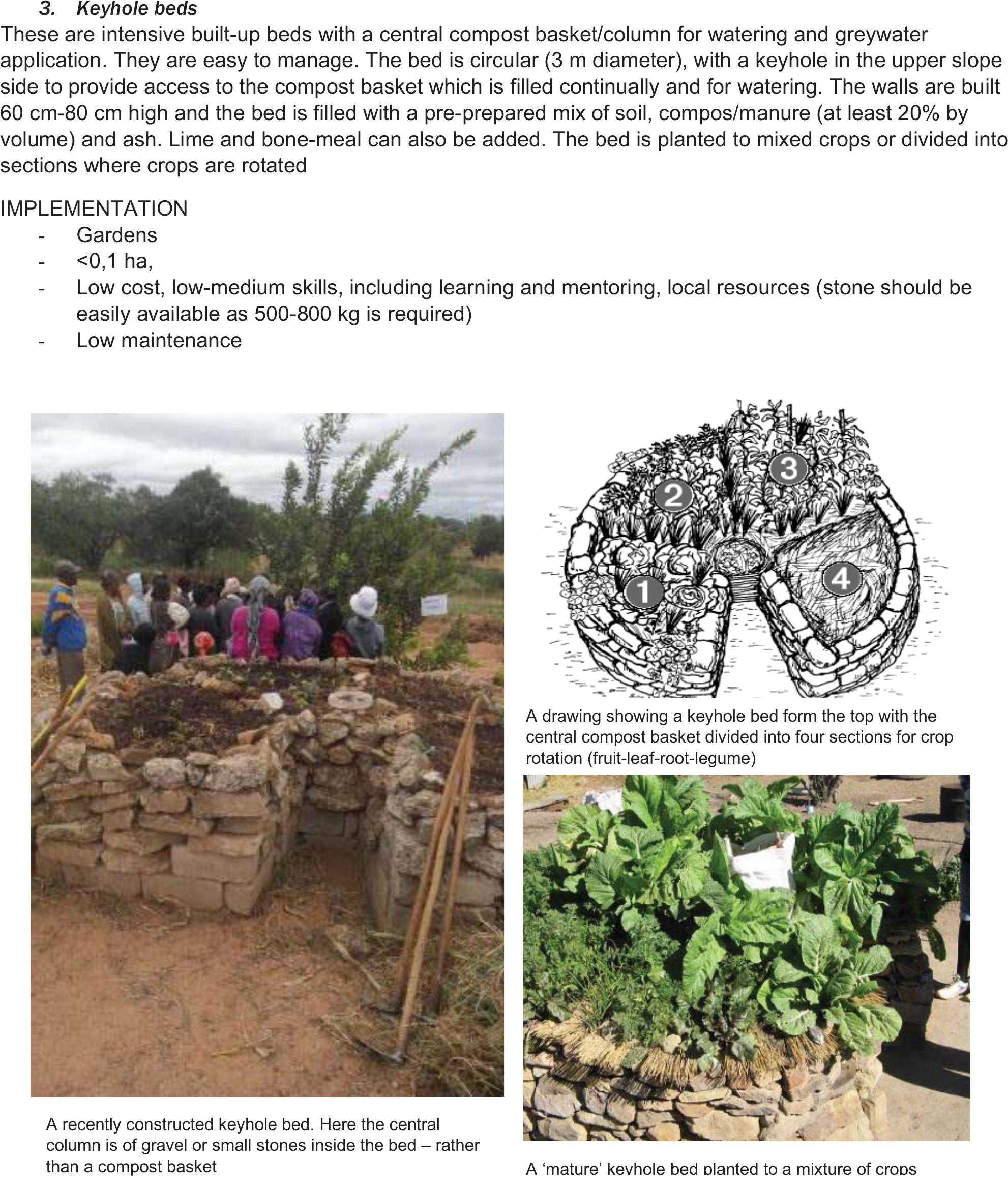
3.Keyhole beds
These are intensive built-up beds with a central compost basket/column for watering and greywater
application. They are easy to manage. The bed is circular (3 m diameter), with a keyhole in the upper slope
side to provide access to the compost basket which is filled continually and for watering. The walls are built
60 cm-80 cm high and the bed is filled with a pre-prepared mix of soil, compos/manure (at least 20% by
volume) and ash. Lime and bone-meal can also be added. The bed is planted to mixed crops or divided into
sections where crops are rotated
IMPLEMENTATION
- Gardens
- <0,1 ha,
-Low cost, low-medium skills, including learning and mentoring, local resources (stone should be
easily available as 500-800 kg is required)
- Low maintenance
A recently constructed keyhole bed. Here the central
column is of gravel or small stones inside the bed – rather
than a compost basket
A drawing showing a keyhole bed form the top with the
central compost basket divided into four sections for crop
rotation
(
fruit-leaf-root-le
g
ume
)
A ‘mature’ ke
y
hole bed
p
lanted to a mixture of cro
p
s
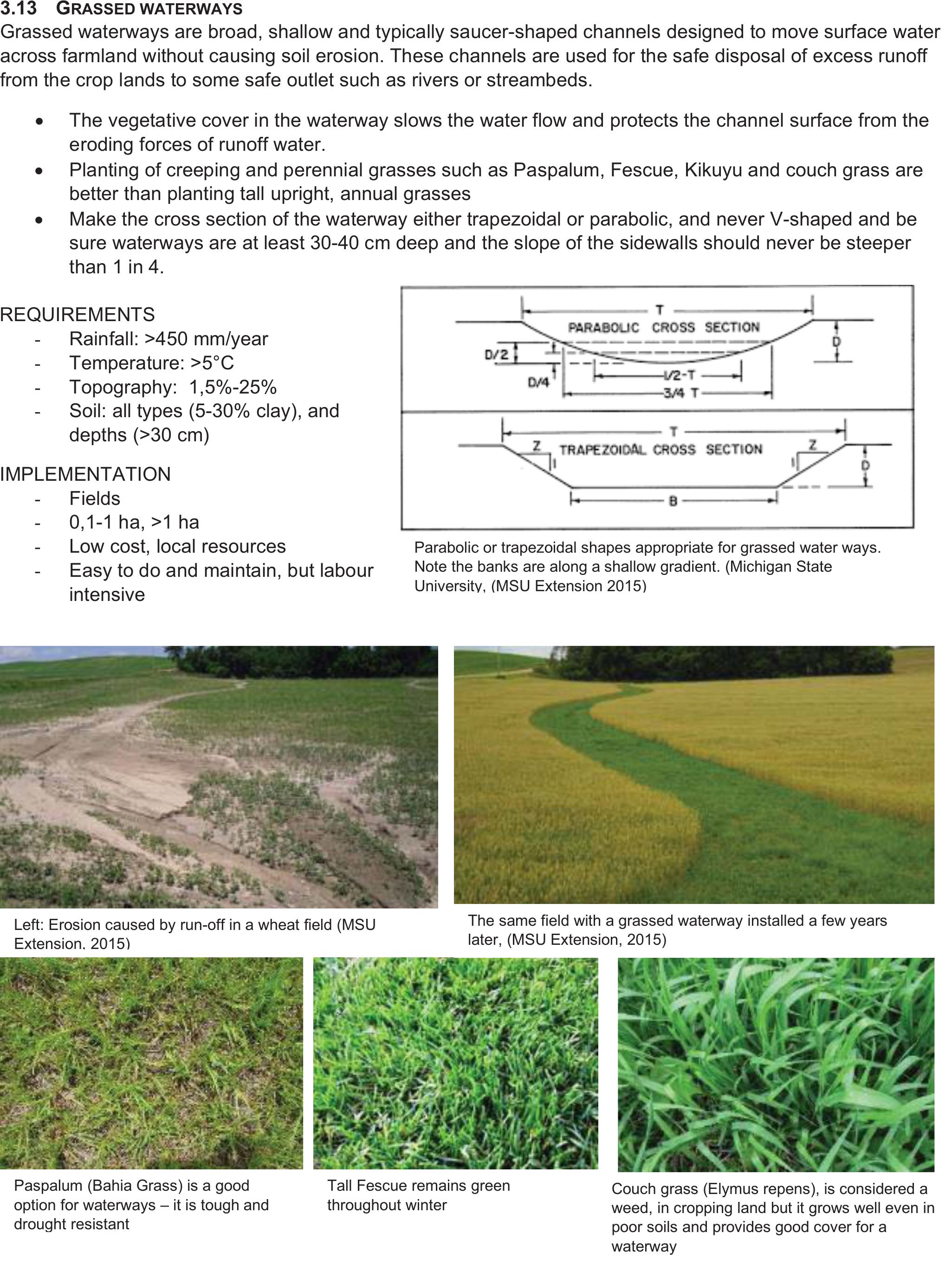
3.13 GRASSED WATERWAYS
Grassed waterways are broad, shallow and typically saucer-shaped channels designed to move surface water
across farmland without causing soil erosion. These channels are used for the safe disposal of excess runoff
from the crop lands to some safe outlet such as rivers or streambeds.
xThe vegetative cover in the waterway slows the water flow and protects the channel surface from the
eroding forces of runoff water.
xPlanting of creeping and perennial grasses such as Paspalum, Fescue, Kikuyu and couch grass are
better than planting tall upright, annual grasses
xMake the cross section of the waterway either trapezoidal or parabolic, and never V-shaped and be
sure waterways are at least 30-40 cm deep and the slope of the sidewalls should never be steeper
than 1 in 4.
REQUIREMENTS
- Rainfall: >450 mm/year
- Temperature: >5°C
-Topography: 1,5%-25%
-Soil: all types (5-30% clay), and
depths (>30 cm)
IMPLEMENTATION
- Fields
-0,1-1 ha, >1 ha
-Low cost, local resources
-Easy to do and maintain, but labour
intensive
Parabolic or trapezoidal shapes appropriate for grassed water ways.
Note the banks are along a shallow gradient. (Michigan State
Universit
y,
(
MSU Extension 2015
)
Left: Erosion caused by run-off in a wheat field (MSU
Extension
,
2015
)
The same field with a grassed waterway installed a few years
later, (MSU Extension, 2015)
Paspalum (Bahia Grass) is a good
option for waterways – it is tough and
drou
g
ht resistant
Tall Fescue remains green
throughout winter
Couch grass (Elymus repens), is considered a
weed, in cropping land but it grows well even in
poor soils and provides good cover for a
waterway
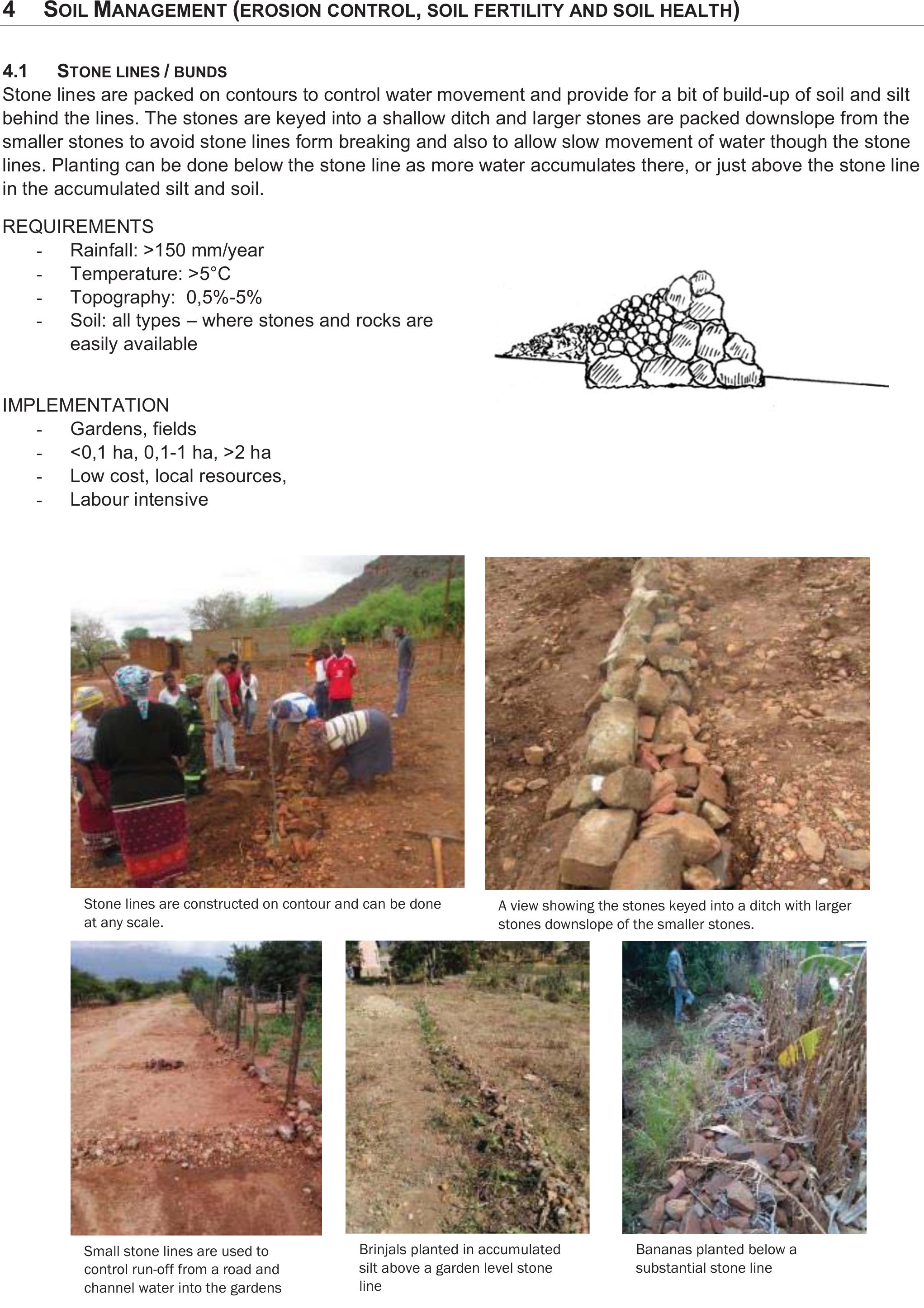
4 SOIL MANAGEMENT (EROSION CONTROL, SOIL FERTILITY AND SOIL HEALTH)
4.1 STONE LINES/ BUNDS
Stone lines are packed on contours to control water movement and provide for a bit of build-up of soil and silt
behind the lines. The stones are keyed into a shallow ditch and larger stones are packed downslope from the
smaller stones to avoid stone lines form breaking and also to allow slow movement of water though the stone
lines. Planting can be done below the stone line as more water accumulates there, or just above the stone line
in the accumulated silt and soil.
REQUIREMENTS
- Rainfall: >150 mm/year
- Temperature: >5°C
- Topography: 0,5%-5%
-Soil: all types – where stones and rocks are
easily available
IMPLEMENTATION
- Gardens, fields
-<0,1 ha, 0,1-1 ha, >2 ha
-Low cost, local resources,
- Labour intensive
Stone lines are constructed on contour and can be done
at any scale.
A view showing the stones keyed into a ditch with larger
stones downslope of the smaller stones.
Small stone lines are used to
control run-off from a road and
channel water into the gardens
Brinjals planted in accumulated
silt above a garden level stone
line
Bananas planted below a
substantial stone line

4.2 CHECK DAMS
A check dam is a small, sometimes temporary, dam constructed perpendicularly across a drainage ditch, or
waterway to counteract erosion by reducing water flow velocity and allowing sedimentation of silt. Different
materials can be used including soil, stones, wood and vegetation. The stones or other materials, are keyed
into the slope, on contour, to reduce erosion caused by overland flow of water. The outcome is the formation
of small benched terraces of fertile soil for plant growth.
Check dams are mostly placed across drainage lines where water flows after rainfall; but does not flow
permanently. They are also placed across eroding gullies. They work well to stabilise roads or paths that
cross drainage lines. Angular, rather than round rocks should be used and the bottom layers should be large
30 cm-60 m wide and around 5-9 kg in weight. The smaller stones at the top and for the apron can be 15 cm-
22 cm in diameter. Ideally a series of check dams should be placed heel-to toe; where the level terrace of
accumulated sediment and soil behind each check dam extends to the downstream end of the check dam
higher up.
REQUIREMENTS
- Rainfall: >150 mm/year
- Temperature: >5°C
-Topography: 1,5%-25%
-Soil: all types – where stones and rocks are
easily available
IMPLEMENTATION
- Gardens, fields
-<0,1 ha, 0,1-1 ha, >2 ha
-Low cost, local resources,
- Labour intensive
Gulley forming in a field
Digging the ditch for keying in the
stones for the check dam
Starting to pack the check dam. Large rocks go at
the bottom
An example of a completed check dam with
the apron below the wall and the banana
shape of the wall visible.

4.3 TERRACES
A terrace is a level strip of soil built along the contour of a slope and supported by an earth or stone bund, or
rows of old tyres. Terraces create flat planting areas and stabilize slopes which would otherwise be too steep
for crop production. A series of terraces creates a step-like effect which slows down runoff, increases the
infiltration of water into the soil, and helps control soil erosion. Terraces are built on steeper slopes.
REQUIREMENTS
- Rainfall: >350 mm/year
- Temperature: >5°C
- Topography: 10%-40%%
-Soil: all types – where stones and rocks are easily
available
IMPLEMENTATION
- Gardens, fields
-<0,1 ha, 0,1-1 ha, >2 ha
-Low cost, local resources
- Labour intensive
Stone terraces for field cropping
Terraces can also be built using old tyres in areas where
stones are scarce
A view of a slope where field terraces have been made for maize
production (~20% slope)
A view of garden level terraces on a steep bank. (~40%
slope)
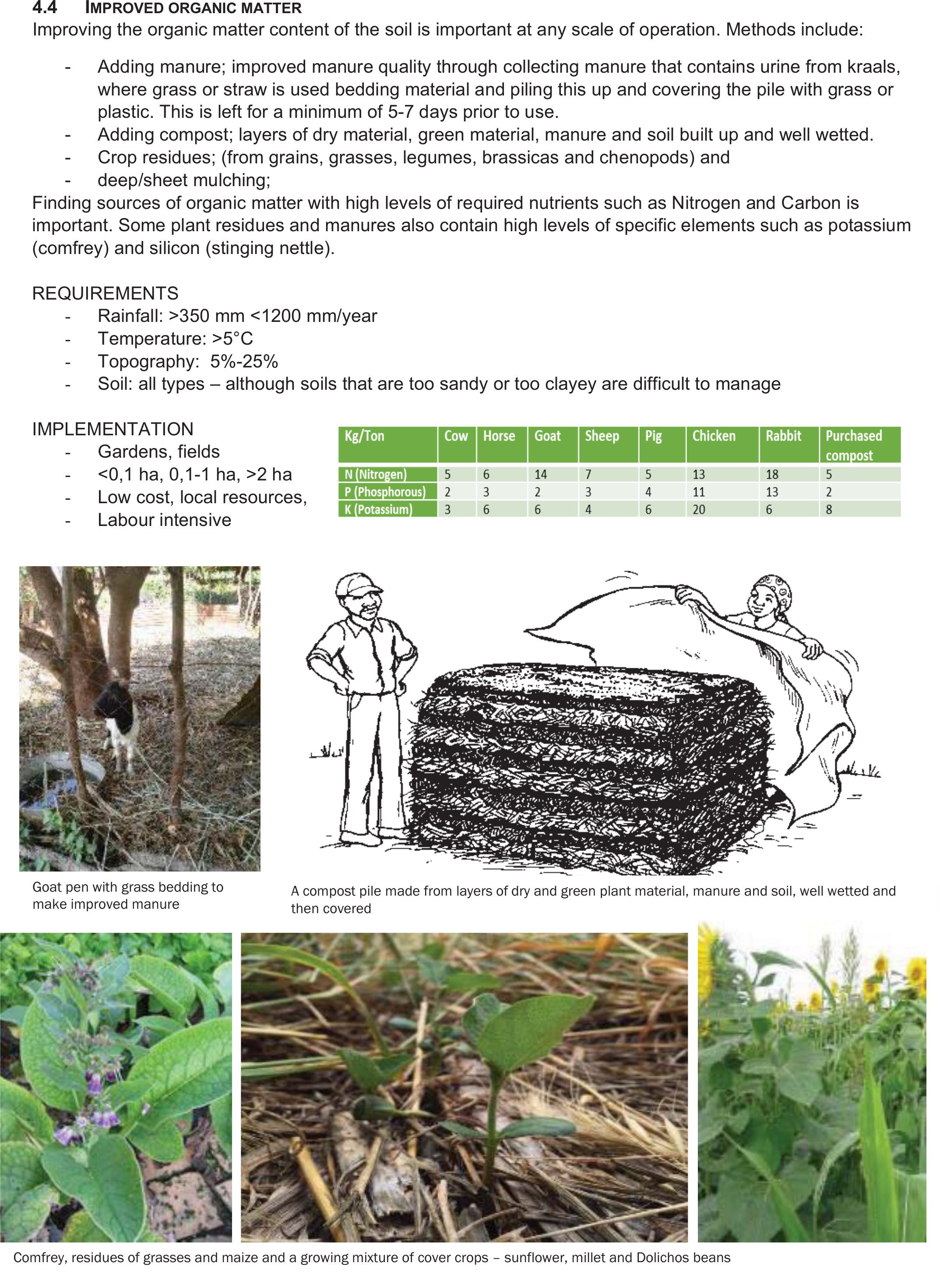
4.4 IMPROVED ORGANIC MATTER
Improving the organic matter content of the soil is important at any scale of operation. Methods include:
- Adding manure; improved manure quality through collecting manure that contains urine from kraals,
where grass or straw is used bedding material and piling this up and covering the pile with grass or
plastic. This is left for a minimum of 5-7 days prior to use.
- Adding compost; layers of dry material, green material, manure and soil built up and well wetted.
- Crop residues; (from grains, grasses, legumes, brassicas and chenopods) and
- deep/sheet mulching;
Finding sources of organic matter with high levels of required nutrients such as Nitrogen and Carbon is
important. Some plant residues and manures also contain high levels of specific elements such as potassium
(comfrey) and silicon (stinging nettle).
REQUIREMENTS
-Rainfall: >350 mm <1200 mm/year
- Temperature: >5°C
- Topography: 5%-25%
-Soil: all types – although soils that are too sandy or too clayey are difficult to manage
IMPLEMENTATION
- Gardens, fields
-<0,1 ha, 0,1-1 ha, >2 ha
-Low cost, local resources,
- Labour intensive
Goat pen with grass bedding to
make improved manureA compost pile made from layers of dry and green plant material, manure and soil, well wetted and
then covered
Comfrey, residues of grasses and maize and a growing mixture of cover crops – sunflower, millet and Dolichos beans
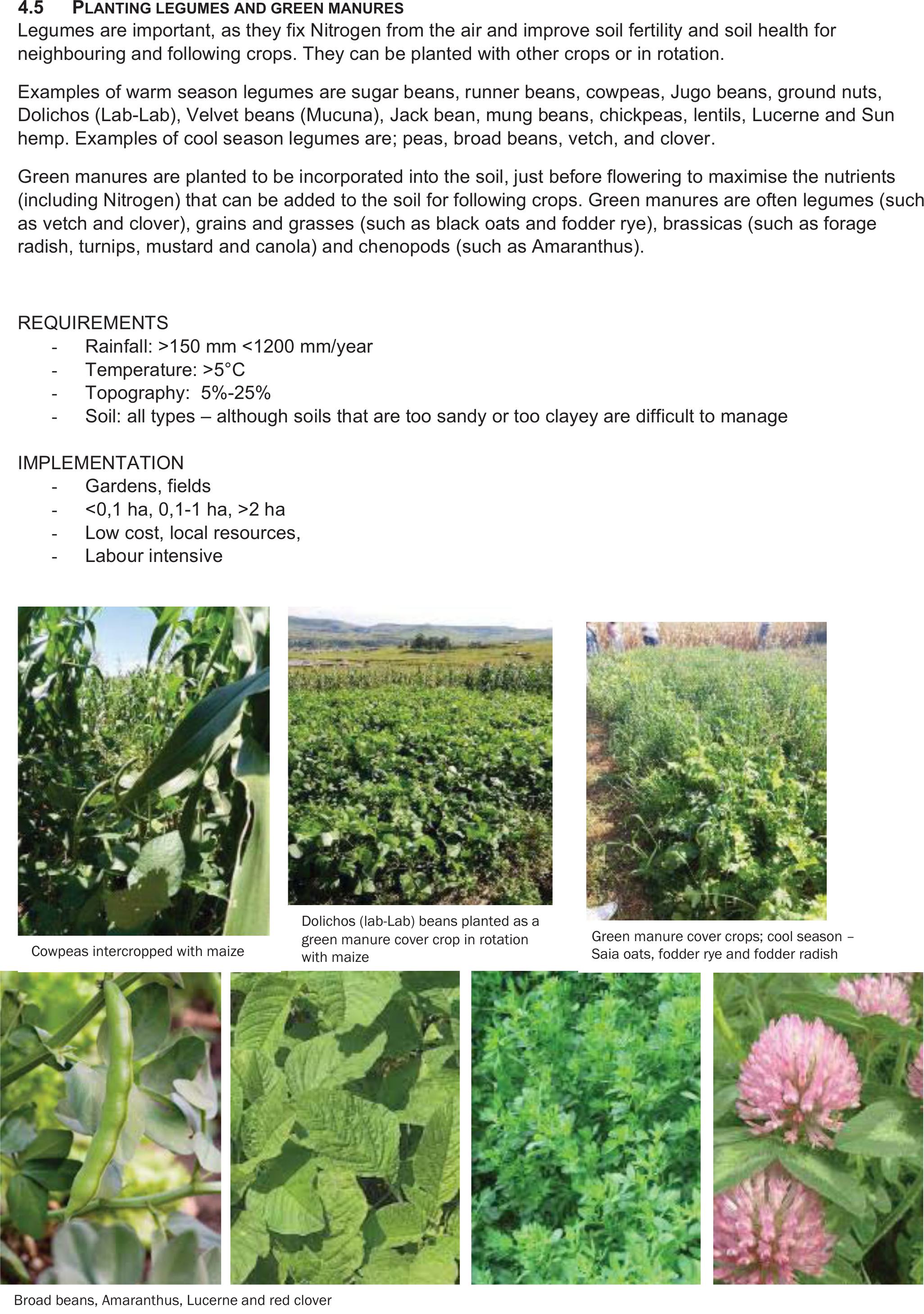
4.5 PLANTING LEGUMES AND GREEN MANURES
Legumes are important, as they fix Nitrogen from the air and improve soil fertility and soil health for
neighbouring and following crops. They can be planted with other crops or in rotation.
Examples of warm season legumes are sugar beans, runner beans, cowpeas, Jugo beans, ground nuts,
Dolichos (Lab-Lab), Velvet beans (Mucuna), Jack bean, mung beans, chickpeas, lentils, Lucerne and Sun
hemp. Examples of cool season legumes are; peas, broad beans, vetch, and clover.
Green manures are planted to be incorporated into the soil, just before flowering to maximise the nutrients
(including Nitrogen) that can be added to the soil for following crops. Green manures are often legumes (such
as vetch and clover), grains and grasses (such as black oats and fodder rye), brassicas (such as forage
radish, turnips, mustard and canola) and chenopods (such as Amaranthus).
REQUIREMENTS
-Rainfall: >150 mm <1200 mm/year
- Temperature: >5°C
- Topography: 5%-25%
-Soil: all types – although soils that are too sandy or too clayey are difficult to manage
IMPLEMENTATION
- Gardens, fields
-<0,1 ha, 0,1-1 ha, >2 ha
-Low cost, local resources,
- Labour intensive
Cowpeas intercropped with maize
Dolichos (lab-Lab) beans planted as a
green manure cover crop in rotation
with maize
Green manure cover crops; cool season –
Saia oats, fodder rye and fodder radish
Broad beans, Amaranthus, Lucerne and red clover
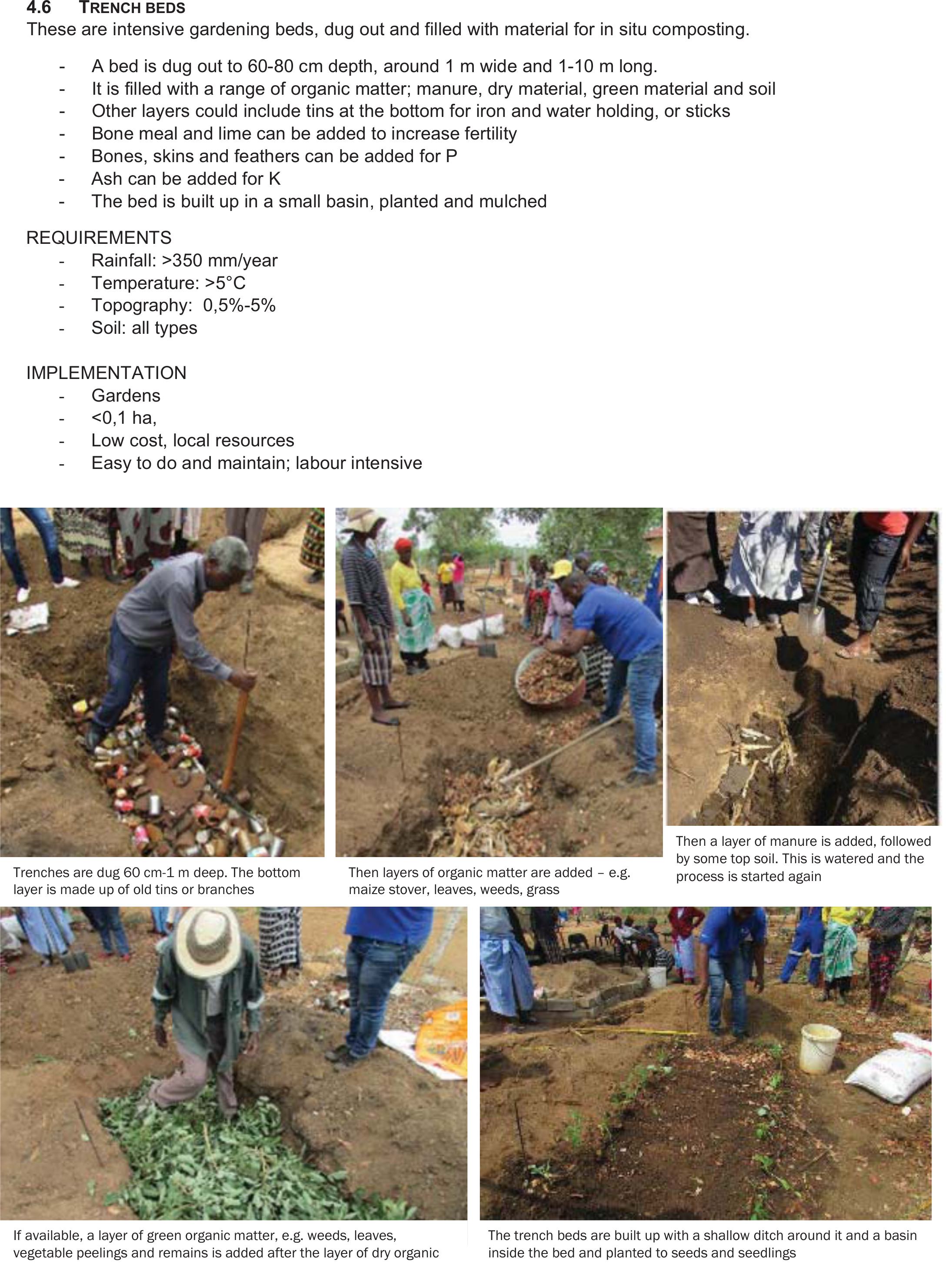
4.6 TRENCH BEDS
These are intensive gardening beds, dug out and filled with material for in situ composting.
- A bed is dug out to 60-80 cm depth, around 1 m wide and 1-10 m long.
- It is filled with a range of organic matter; manure, dry material, green material and soil
- Other layers could include tins at the bottom for iron and water holding, or sticks
- Bone meal and lime can be added to increase fertility
- Bones, skins and feathers can be added for P
- Ash can be added for K
- The bed is built up in a small basin, planted and mulched
REQUIREMENTS
- Rainfall: >350 mm/year
- Temperature: >5°C
- Topography: 0,5%-5%
- Soil: all types
IMPLEMENTATION
- Gardens
- <0,1 ha,
-Low cost, local resources
-Easy to do and maintain; labour intensive
Trenches are dug 60 cm-1 m deep. The bottom
layer is made up of old tins or branches
Then layers of organic matter are added – e.g.
maize stover, leaves, weeds, grass
Then a layer of manure is added, followed
by some top soil. This is watered and the
process is started again
If available, a layer of green organic matter,e.g. weeds, leaves,
vegetable peelings and remains is added after the layer of dry organic
The trench beds are built up with a shallow ditch around it and a basin
inside the bed and planted to seeds and seedlings
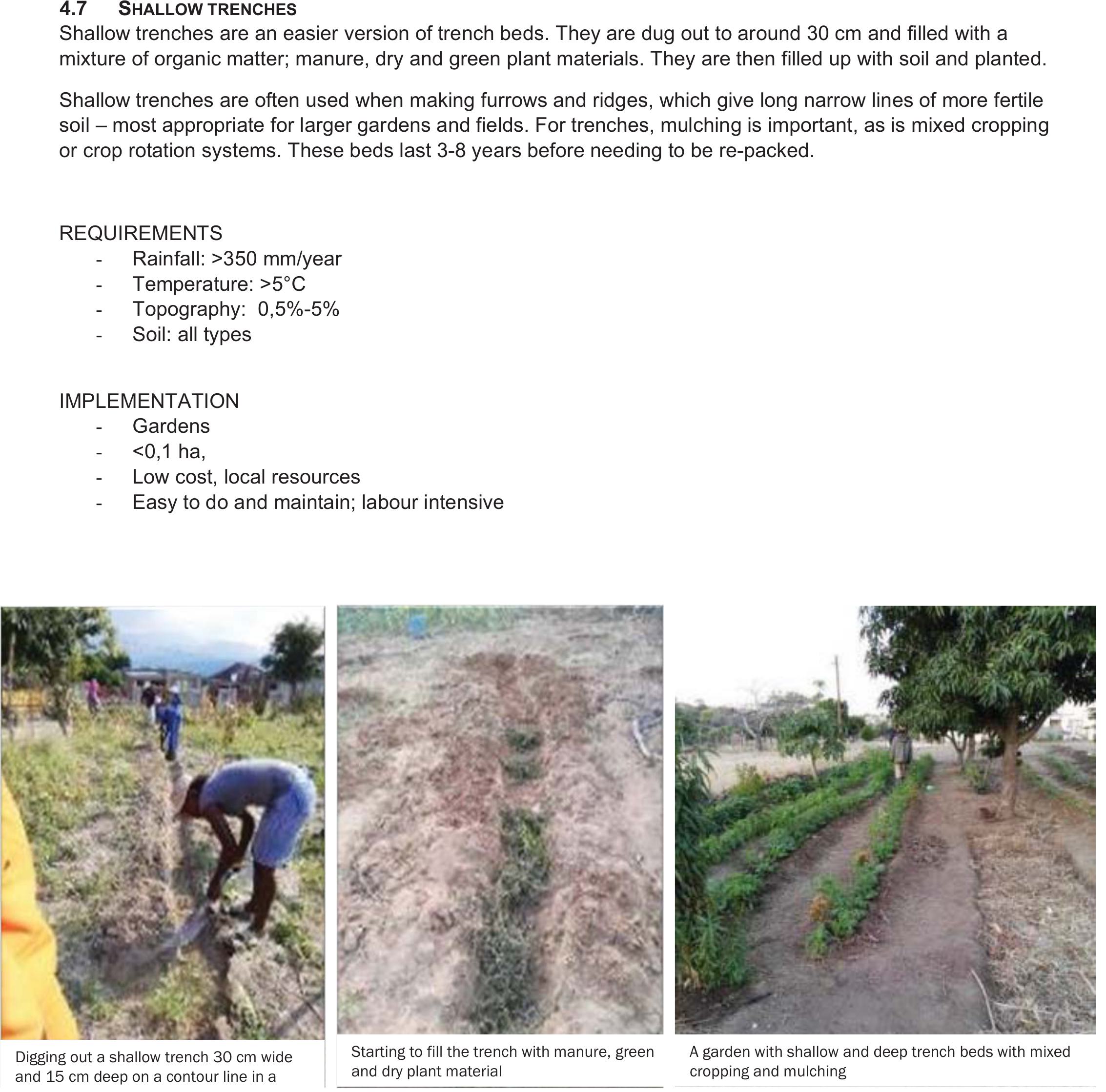
4.7 SHALLOW TRENCHES
Shallow trenches are an easier version of trench beds. They are dug out to around 30 cm and filled with a
mixture of organic matter; manure, dry and green plant materials. They are then filled up with soil and planted.
Shallow trenches are often used when making furrows and ridges, which give long narrow lines of more fertile
soil – most appropriate for larger gardens and fields. For trenches, mulching is important, as is mixed cropping
or crop rotation systems. These beds last 3-8 years before needing to be re-packed.
REQUIREMENTS
- Rainfall: >350 mm/year
- Temperature: >5°C
- Topography: 0,5%-5%
- Soil: all types
IMPLEMENTATION
- Gardens
- <0,1 ha,
-Low cost, local resources
-Easy to do and maintain; labour intensive
Digging out a shallow trench 30 cm wide
and 15 cm deep on a contour line in a
Starting to fill the trench with manure, green
and dry plant material
A garden with shallow and deep trench beds with mixed
croppin
g
and mulchin
g
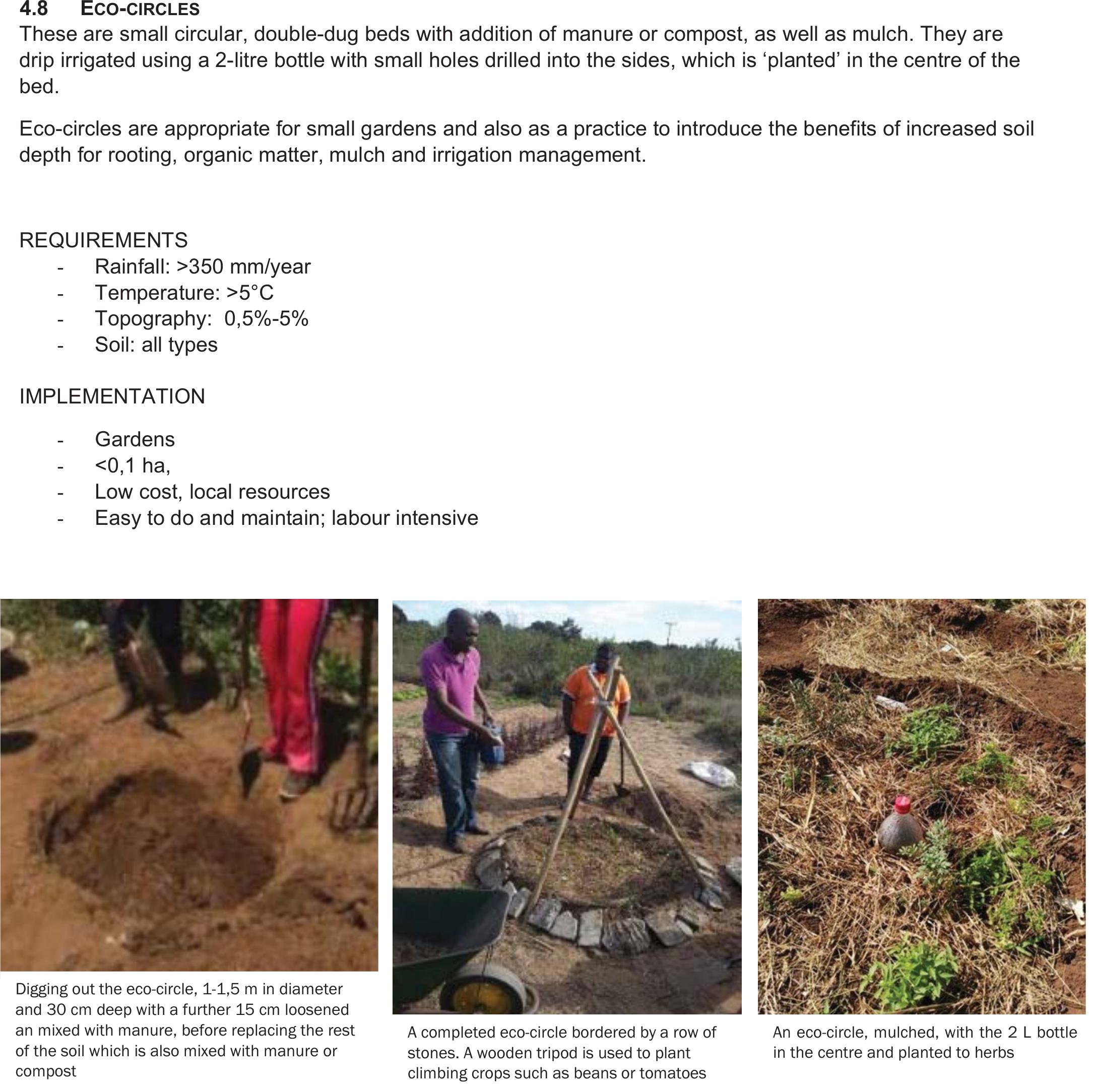
4.8 ECO-CIRCLES
These are small circular, double-dug beds with addition of manure or compost, as well as mulch. They are
drip irrigated using a 2-litre bottle with small holes drilled into the sides, which is ‘planted’ in the centre of the
bed.
Eco-circles are appropriate for small gardens and also as a practice to introduce the benefits of increased soil
depth for rooting, organic matter, mulch and irrigation management.
REQUIREMENTS
- Rainfall: >350 mm/year
- Temperature: >5°C
- Topography: 0,5%-5%
- Soil: all types
IMPLEMENTATION
- Gardens
- <0,1 ha,
-Low cost, local resources
-Easy to do and maintain; labour intensive
Digging out the eco-circle, 1-1,5 m in diameter
and 30 cm deep with a further 15 cm loosened
an mixed with manure, before replacing the rest
of the soil which is also mixed with manure or
compost
A completed eco-circle bordered by a row of
stones. A wooden tripod is used to plant
climbing crops such as beans or tomatoes
An eco-circle, mulched, with the 2 L bottle
in the centre and planted to herbs
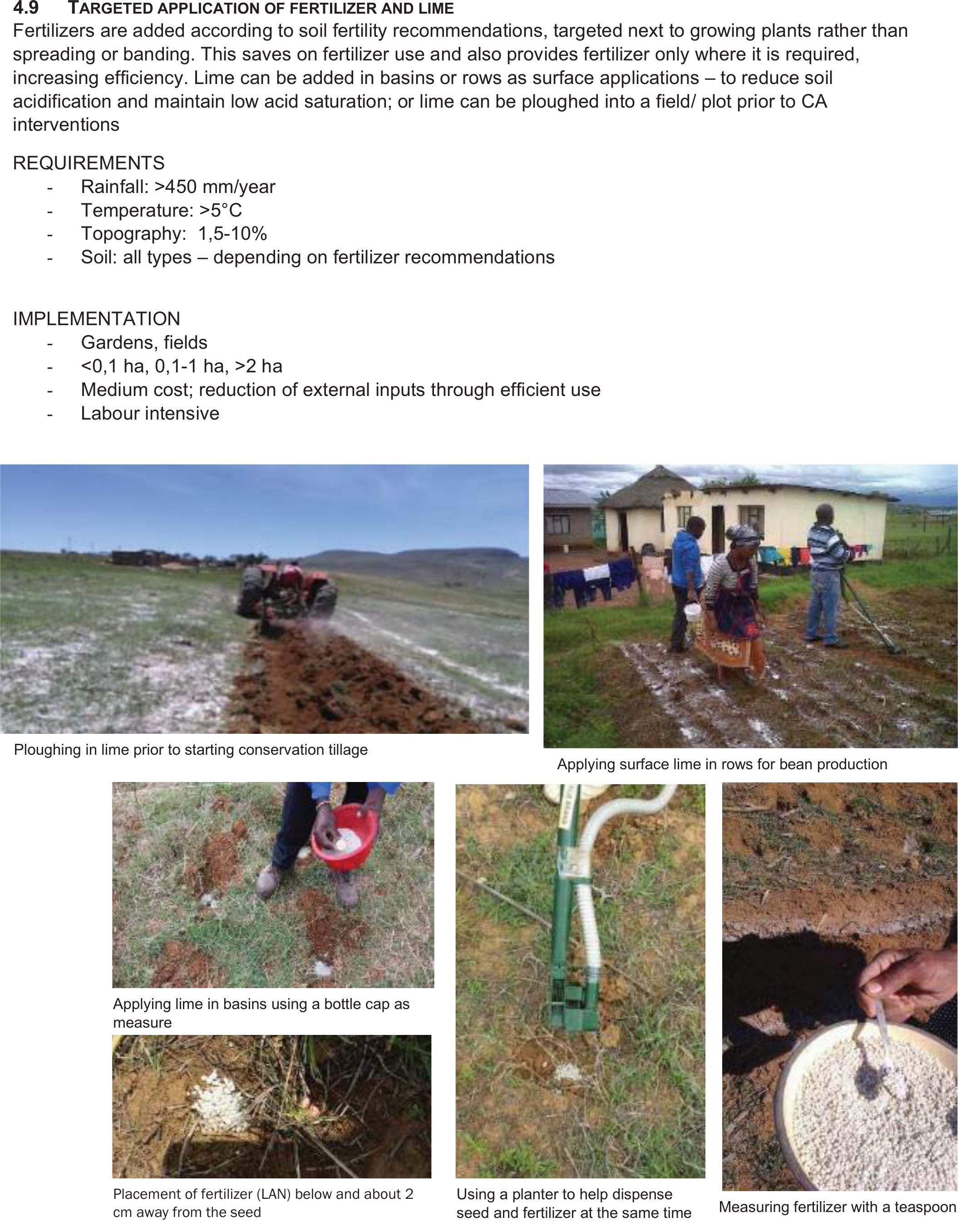
4.9 TARGETED APPLICATION OF FERTILIZER AND LIME
Fertilizers are added according to soil fertility recommendations, targeted next to growing plants rather than
spreading or banding. This saves on fertilizer use and also provides fertilizer only where it is required,
increasing efficiency. Lime can be added in basins or rows as surface applications – to reduce soil
acidification and maintain low acid saturation; or lime can be ploughed into a field/ plot prior to CA
interventions
REQUIREMENTS
- Rainfall: >450 mm/year
- Temperature: >5°C
- Topography: 1,5-10%
-Soil: all types – depending on fertilizer recommendations
IMPLEMENTATION
- Gardens, fields
-<0,1 ha, 0,1-1 ha, >2 ha
-Medium cost; reduction of external inputs through efficient use
- Labour intensive
Applying lime in basins using a bottle cap as
measure
Placement of fertilizer (LAN) below and about 2
cm away from the seed
Ploughing in lime prior to starting conservation tillage Applying surface lime in rows for bean production
Using a planter to help dispense
seed and fertilizer at the same time Measuring fertilizer with a teaspoon

4.10 ZAI PITS /PLANTING BASINS
A zai is a hole or planting pit, usually with a diameter of 20-40 cm and a depth of 10-20 cm. The Zai pits
capture rain and surface run-off water and protect the seeds and organic matter from being washed away.
They also help to concentrate water and nutrients for the crops. Pits are dug during the dry season. The
excavated earth is ridged around the demi-circle to improve the water retention capacity of the pit. After
digging the pits, composted organic matter is added at an average, recommended rate of 0.6 kg/pit and, after
the first rainfall, the matter is covered with a thin layer of soil and the seeds placed in the middle of the pit.
REQUIREMENTS
- Rainfall: >350 mm/year
- Temperature: >5°C
-Topography: 1,5%-25%
-Soil: all types (5-30% clay), and depths (>30 cm)
IMPLEMENTATION
- Gardens, fields
-0,1 ha-1 ha, >1 ha
-Low cost, local resources
-Easy to do and maintain; labour intensive
Zai
p
its in Ken
y
a
,
p
lanted to maize and then mulched for increased moisture holdin
g
and soil fertilit
y
(
from
p
ermies.com
,
2017
)
Zai pits dug in an eroded field, with composting material ready
to be added
(
from Chris Rei
j
, 2010
)
Maize planted in Zai pits, in Kenya (from Inadesforum.net
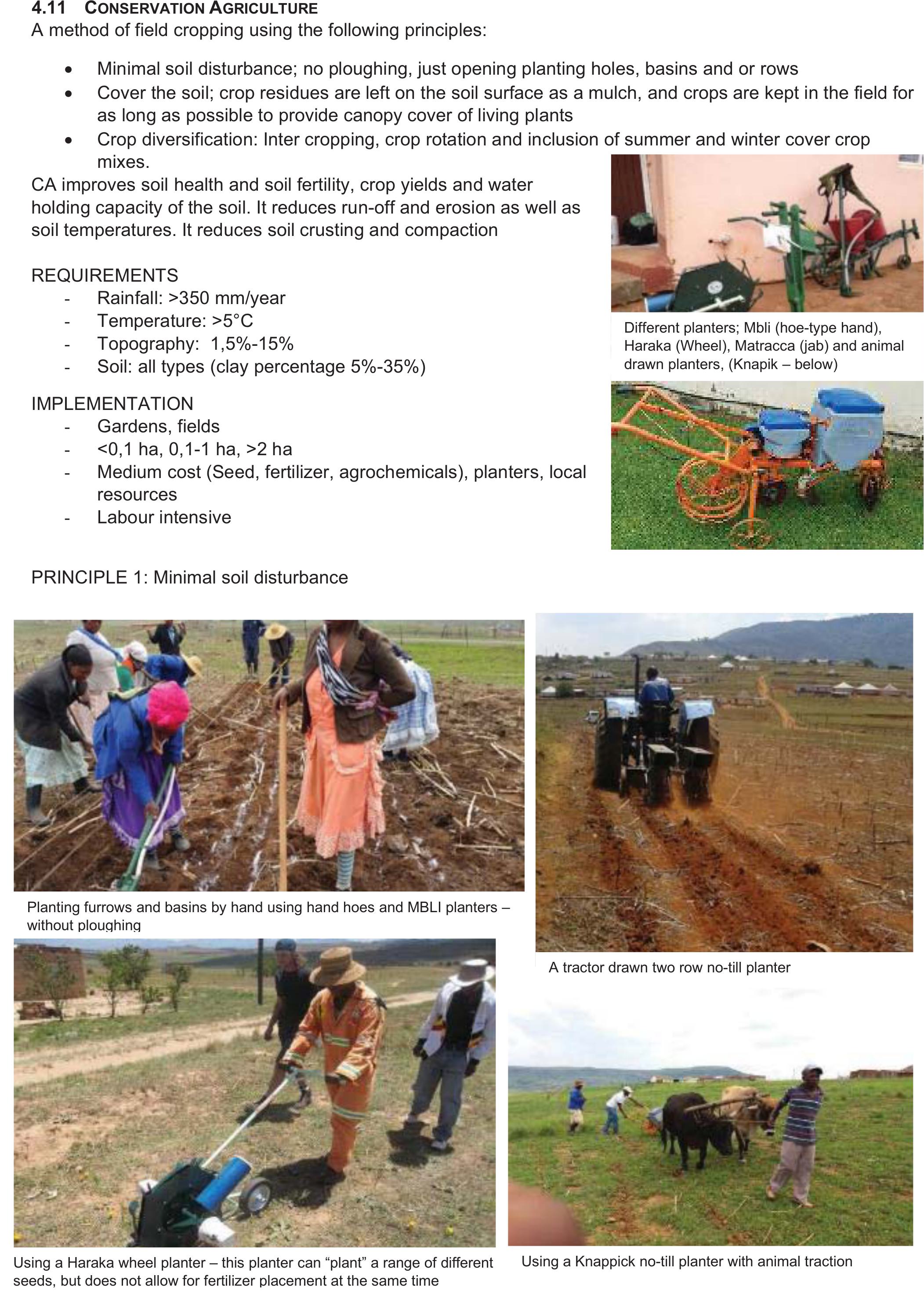
4.11 CONSERVATION AGRICULTURE
A method of field cropping using the following principles:
xMinimal soil disturbance; no ploughing, just opening planting holes, basins and or rows
xCover the soil; crop residues are left on the soil surface as a mulch, and crops are kept in the field for
as long as possible to provide canopy cover of living plants
xCrop diversification: Inter cropping, crop rotation and inclusion of summer and winter cover crop
mixes.
CA improves soil health and soil fertility, crop yields and water
holding capacity of the soil. It reduces run-off and erosion as well as
soil temperatures. It reduces soil crusting and compaction
REQUIREMENTS
- Rainfall: >350 mm/year
- Temperature: >5°C
- Topography: 1,5%-15%
-Soil: all types (clay percentage 5%-35%)
IMPLEMENTATION
- Gardens, fields
-<0,1 ha, 0,1-1 ha, >2 ha
-Medium cost (Seed, fertilizer, agrochemicals), planters, local
resources
- Labour intensive
PRINCIPLE 1: Minimal soil disturbance
Different planters; Mbli (hoe-type hand),
Haraka (Wheel), Matracca (jab) and animal
drawn planters, (Knapik – below)
Planting furrows and basins by hand using hand hoes and MBLI planters –
without
p
lou
g
hin
g
A tractor drawn two row no-till planter
Using a Haraka wheel planter – this planter can “plant” a range of different
seeds
,
but does not allow for fertilizer
p
lacement at the same time
Using a Knappick no-till planter with animal traction
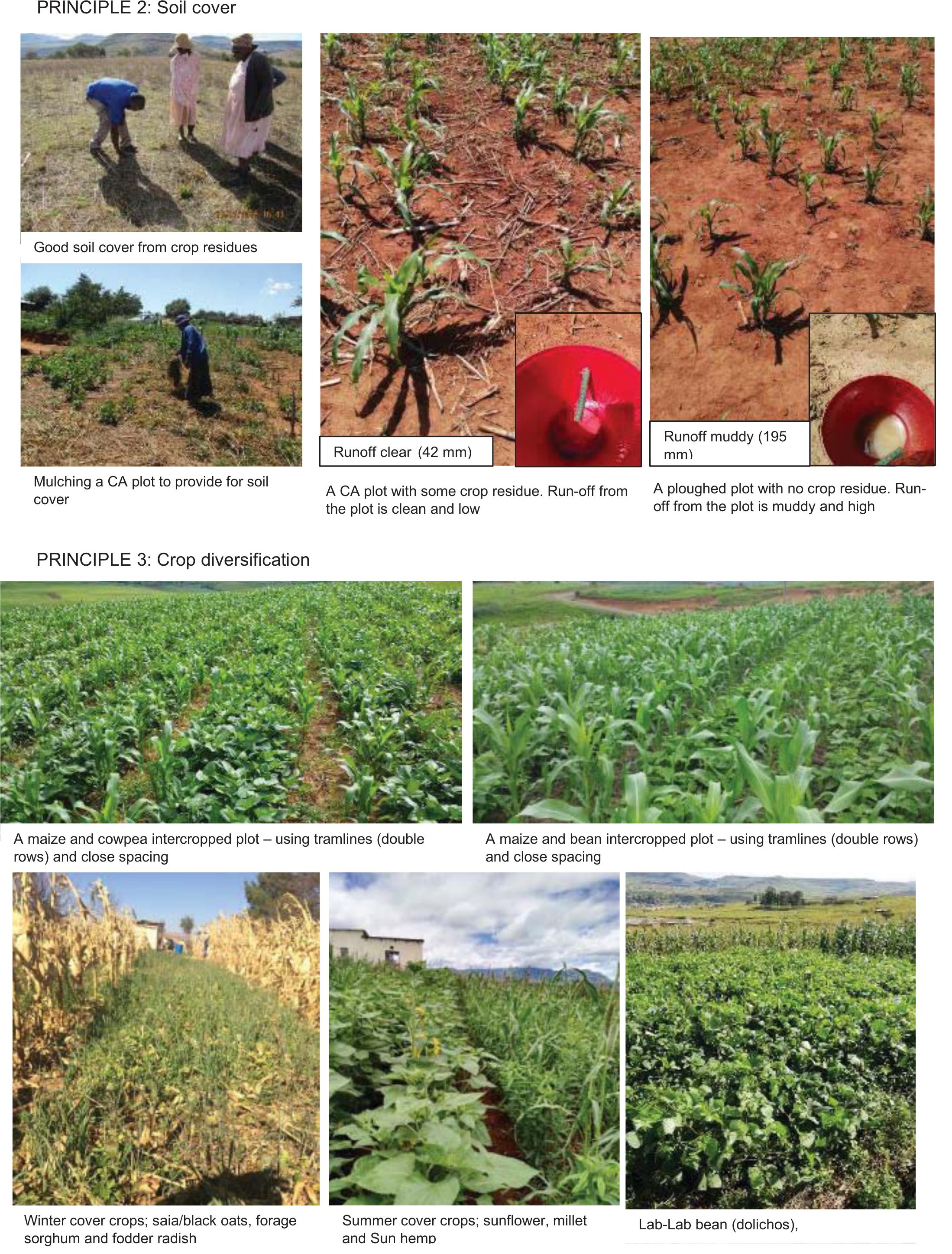
PRINCIPLE 2: Soil cover
PRINCIPLE 3: Crop diversification
A maize and bean intercropped plot – using tramlines (double rows)
and close spacing
A maize and cowpea intercropped plot – using tramlines (double
rows) and close spacing
Winter cover crops; saia/black oats, forage
sorghum and fodder radish
Summer cover crops; sunflower, millet
and Sun hem
p
Lab-Lab bean (dolichos),
Runoff clear
(
42 mm
)
Runoff muddy (195
mm)
A CA plot with some crop residue. Run-off from
the plot is clean and low
Mulching a CA plot to provide for soil
cover
Good soil cover from crop residues
A ploughed plot with no crop residue. Run-
off from the plot is muddy and high

4.12 STRIP CROPPING
Strip cropping is cultivation in which different crops are sown in alternate strips to prevent soil erosion and
optimise nutrient uptake. Planting of strips have to be across the slope or on contour.
Crops need to be chosen to have a mixture of rooting depths and nutrient requirements. Strip cropping of
multifunctional species is a good idea. Agroforestry species such as Pigeon Pea, Moringa, Sesbania sesban,
Leuceana, etc. work well. Grasses such as vetiver, lemon grass and Napier fodder can also be used, as well
as Rhodes-Smutsfinger (Digitaria) mix, Paspalum notatum and Tall Fescue.
REQUIREMENTS
- Rainfall: >350 mm/year
- Temperature: >5°C
- Topography: 1,5%-15%
-Soil: all types (clay percentage 5%-35%)
IMPLEMENTATION
- Gardens, fields
-<0,1 ha, 0,1-1 ha, >2 ha
-Low cost (Seed, local resources)
- Labour intensive
Strip cropping of maize with Paspalum and Digitaria
Strip cropping Pigeon pea/Leuceana and maize Grass strips on contour in between maize
Maize and Lucerne or Lespedeza strip cropping
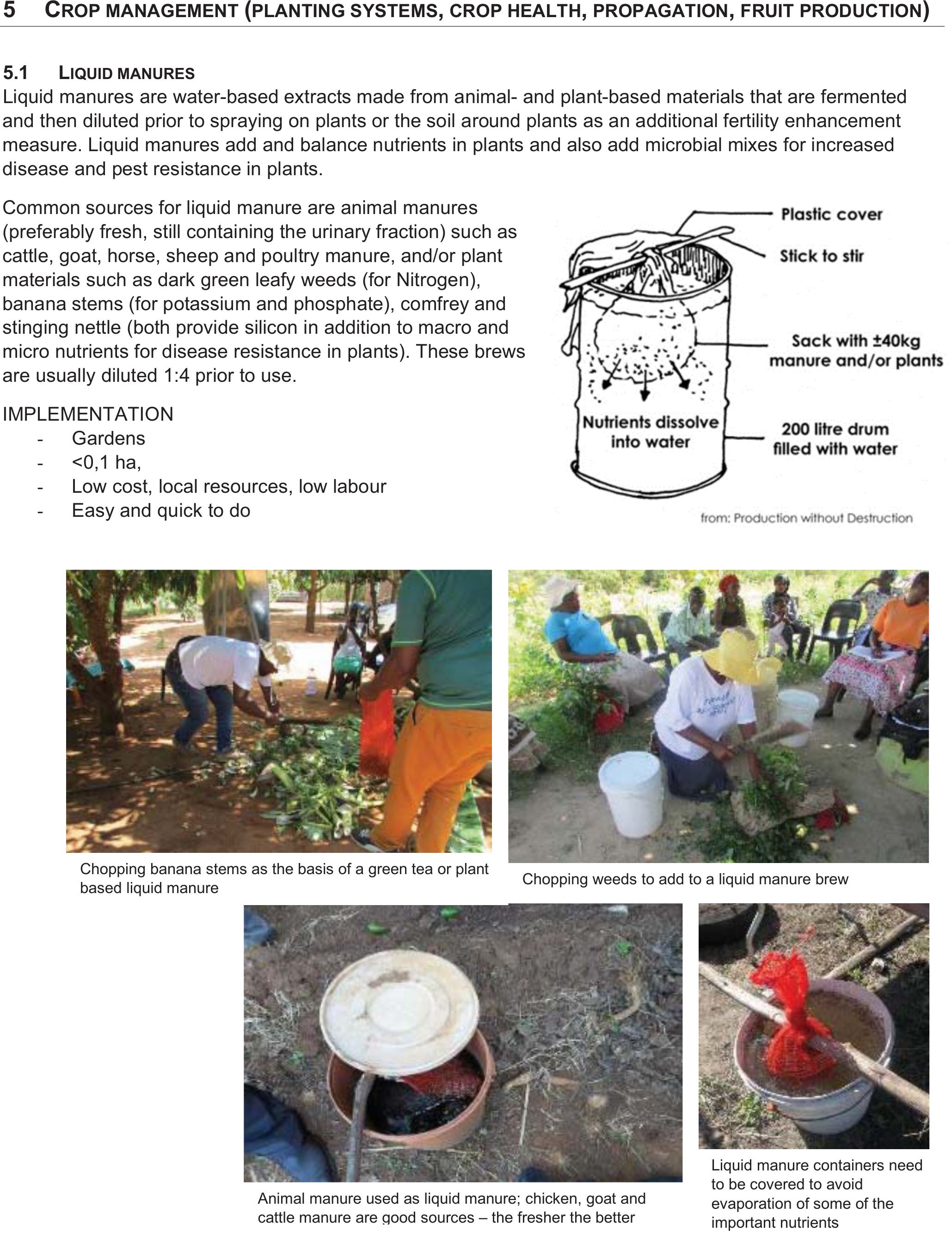
5 CROP MANAGEMENT (PLANTING SYSTEMS, CROP HEALTH, PROPAGATION, FRUIT PRODUCTION)
5.1 LIQUID MANURES
Liquid manures are water-based extracts made from animal- and plant-based materials that are fermented
and then diluted prior to spraying on plants or the soil around plants as an additional fertility enhancement
measure. Liquid manures add and balance nutrients in plants and also add microbial mixes for increased
disease and pest resistance in plants.
Common sources for liquid manure are animal manures
(preferably fresh, still containing the urinary fraction) such as
cattle, goat, horse, sheep and poultry manure, and/or plant
materials such as dark green leafy weeds (for Nitrogen),
banana stems (for potassium and phosphate), comfrey and
stinging nettle (both provide silicon in addition to macro and
micro nutrients for disease resistance in plants). These brews
are usually diluted 1:4 prior to use.
IMPLEMENTATION
- Gardens
- <0,1 ha,
-Low cost, local resources, low labour
-Easy and quick to do
Chopping banana stems as the basis of a green tea or plant
based liquid manure Chopping weeds to add to a liquid manure brew
Animal manure used as liquid manure; chicken, goat and
cattle manure are
g
ood sources – the fresher the better
Liquid manure containers need
to be covered to avoid
evaporation of some of the
important nutrients
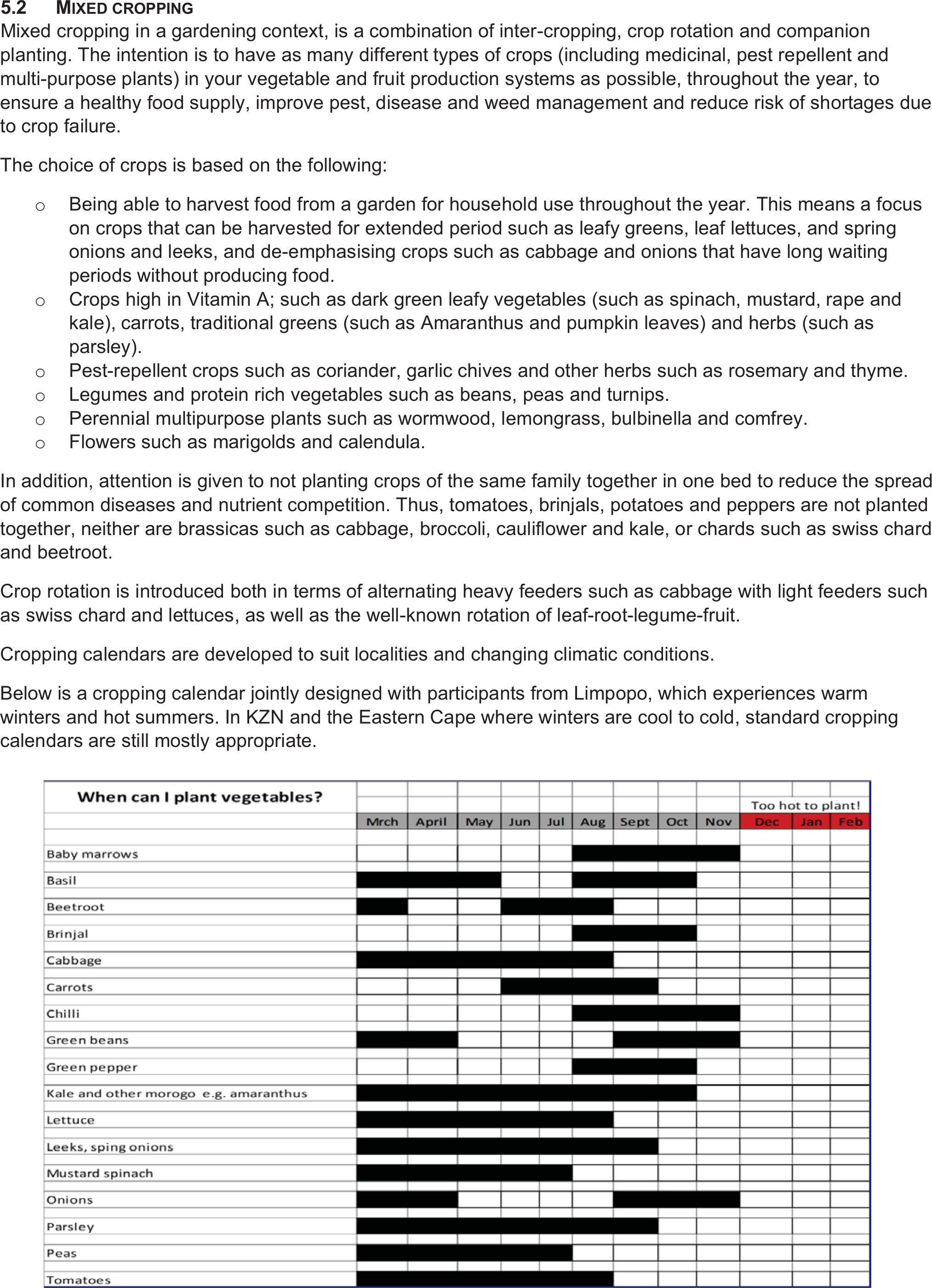
5.2 MIXED CROPPING
Mixed cropping in a gardening context, is a combination of inter-cropping, crop rotation and companion
planting. The intention is to have as many different types of crops (including medicinal, pest repellent and
multi-purpose plants) in your vegetable and fruit production systems as possible, throughout the year, to
ensure a healthy food supply, improve pest, disease and weed management and reduce risk of shortages due
to crop failure.
The choice of crops is based on the following:
oBeing able to harvest food from a garden for household use throughout the year. This means a focus
on crops that can be harvested for extended period such as leafy greens, leaf lettuces, and spring
onions and leeks, and de-emphasising crops such as cabbage and onions that have long waiting
periods without producing food.
oCrops high in Vitamin A; such as dark green leafy vegetables (such as spinach, mustard, rape and
kale), carrots, traditional greens (such as Amaranthus and pumpkin leaves) and herbs (such as
parsley).
oPest-repellent crops such as coriander, garlic chives and other herbs such as rosemary and thyme.
oLegumes and protein rich vegetables such as beans, peas and turnips.
oPerennial multipurpose plants such as wormwood, lemongrass, bulbinella and comfrey.
oFlowers such as marigolds and calendula.
In addition, attention is given to not planting crops of the same family together in one bed to reduce the spread
of common diseases and nutrient competition. Thus, tomatoes, brinjals, potatoes and peppers are not planted
together, neither are brassicas such as cabbage, broccoli, cauliflower and kale, or chards such as swiss chard
and beetroot.
Crop rotation is introduced both in terms of alternating heavy feeders such as cabbage with light feeders such
as swiss chard and lettuces, as well as the well-known rotation of leaf-root-legume-fruit.
Cropping calendars are developed to suit localities and changing climatic conditions.
Below is a cropping calendar jointly designed with participants from Limpopo, which experiences warm
winters and hot summers. In KZN and the Eastern Cape where winters are cool to cold, standard cropping
calendars are still mostly appropriate.
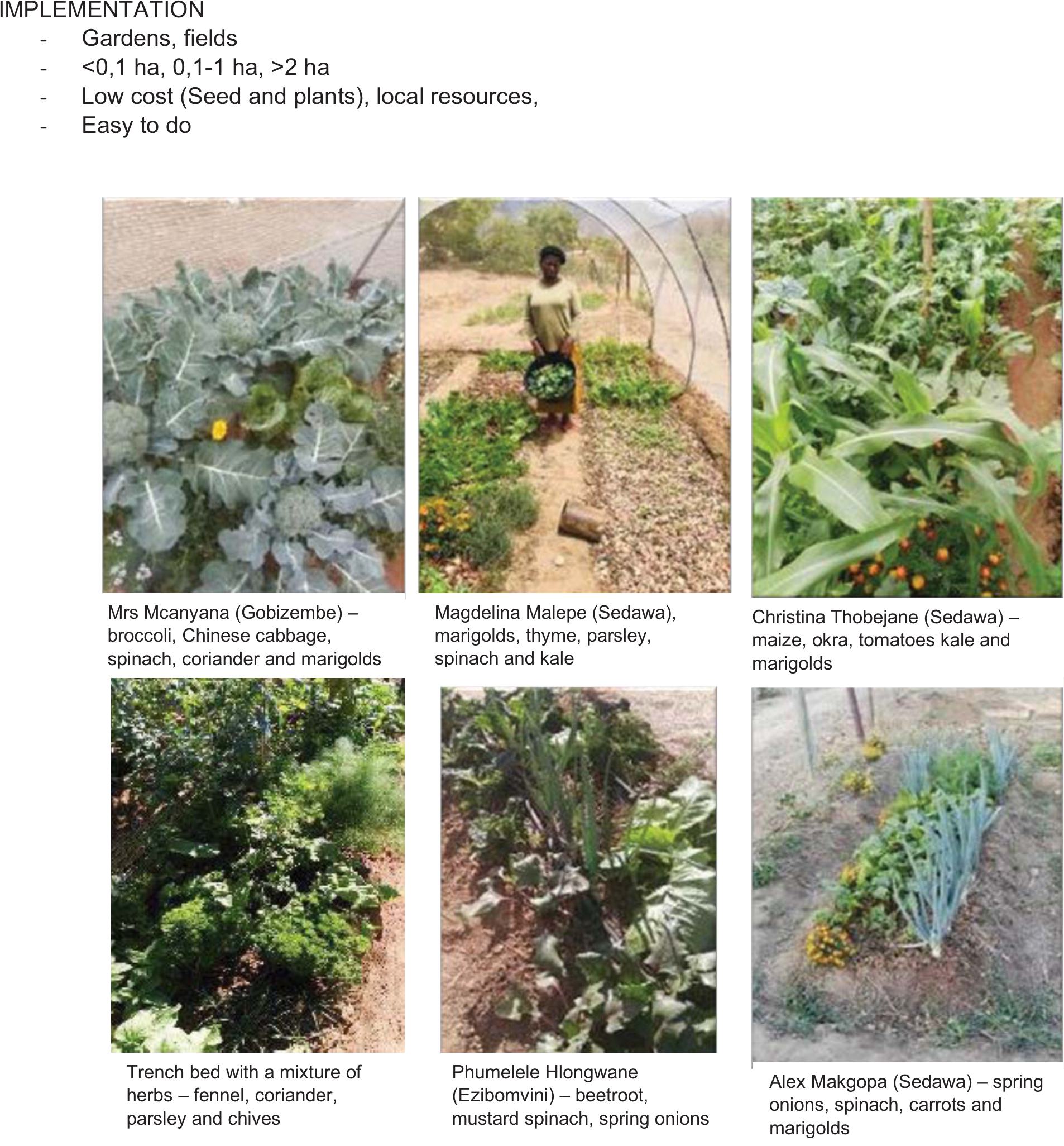
IMPLEMENTATION
- Gardens, fields
-<0,1 ha, 0,1-1 ha, >2 ha
-Low cost (Seed and plants), local resources,
-Easy to do
Magdelina Malepe (Sedawa),
marigolds, thyme, parsley,
s
p
inach and kale
Christina Thobejane (Sedawa) –
maize, okra, tomatoes kale and
marigolds
Phumelele Hlongwane
(Ezibomvini) – beetroot,
mustard spinach, spring onions
Alex Makgopa (Sedawa) – spring
onions, spinach, carrots and
mari
g
olds
Mrs Mcanyana (Gobizembe) –
broccoli, Chinese cabbage,
spinach, coriander and marigolds
Trench bed with a mixture of
herbs – fennel, coriander,
parsley and chives

5.3 CROP ROTATION
Crop rotation is an important management strategy for both gardens and fields. Crop rotation reduces pest and
disease build up in the soil and the environment balances nutrient removal from the soil and maintains and
improves soil health.
Work with a minimum of 3-year rotations in
field crops. An example is Maize (heavy
feeder) rotated with a cover crop mix (such
as Sun hemp, millet and sunflower) (light
feeder) rotated with legumes (such as dry
beans, cowpeas and Dolichos)(legume)
Work with a 3-4 season rotation in
vegetable production. One system is to
move through the following sequence after
digging a trench or adding compost; Fruit;
leaf; root; legume.
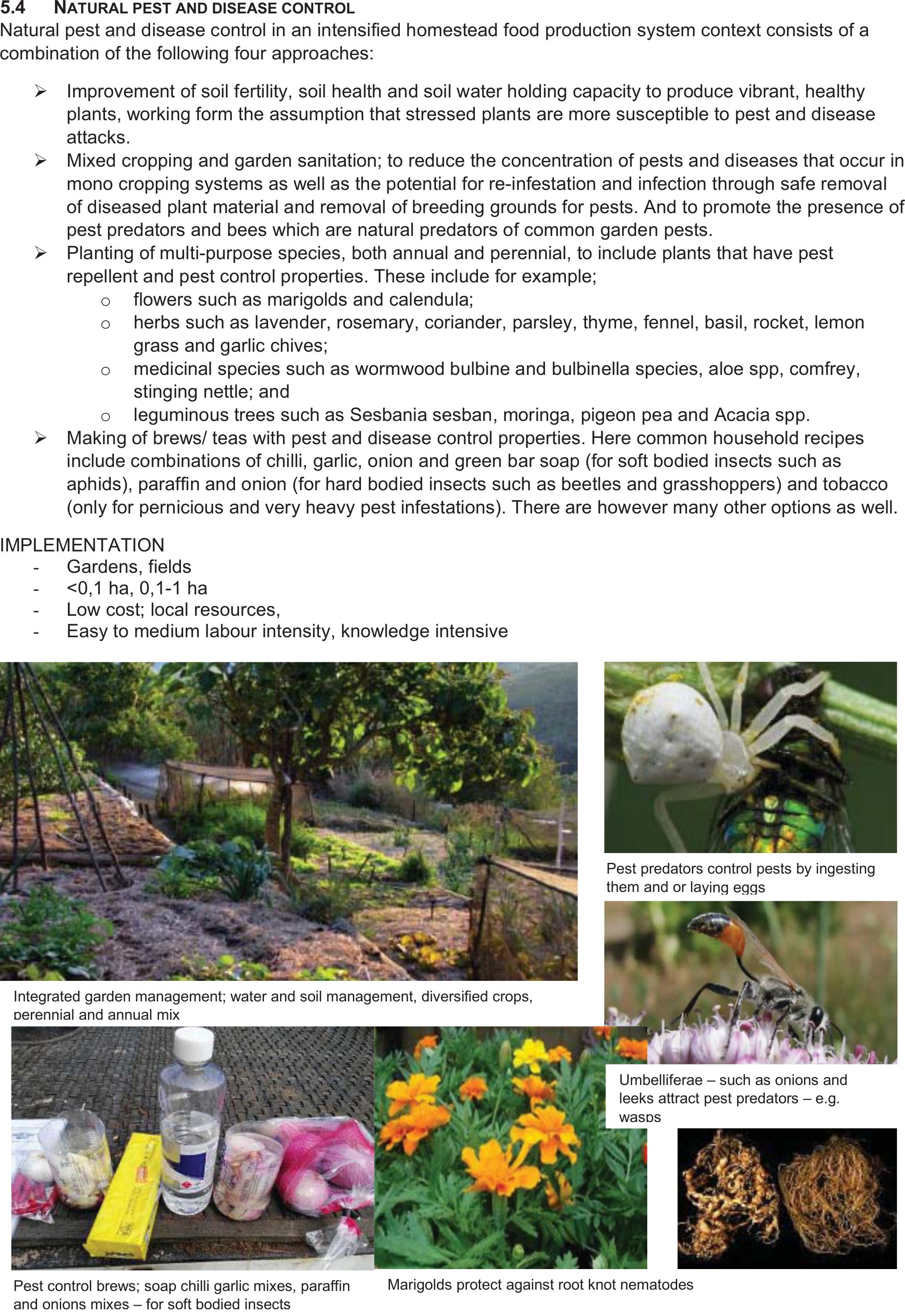
5.4 NATURAL PEST AND DISEASE CONTROL
Natural pest and disease control in an intensified homestead food production system context consists of a
combination of the following four approaches:
¾Improvement of soil fertility, soil health and soil water holding capacity to produce vibrant, healthy
plants, working form the assumption that stressed plants are more susceptible to pest and disease
attacks.
¾Mixed cropping and garden sanitation; to reduce the concentration of pests and diseases that occur in
mono cropping systems as well as the potential for re-infestation and infection through safe removal
of diseased plant material and removal of breeding grounds for pests. And to promote the presence of
pest predators and bees which are natural predators of common garden pests.
¾Planting of multi-purpose species, both annual and perennial, to include plants that have pest
repellent and pest control properties. These include for example;
oflowers such as marigolds and calendula;
oherbs such as lavender, rosemary, coriander, parsley, thyme, fennel, basil, rocket, lemon
grass and garlic chives;
omedicinal species such as wormwood bulbine and bulbinella species, aloe spp, comfrey,
stinging nettle; and
oleguminous trees such as Sesbania sesban, moringa, pigeon pea and Acacia spp.
¾Making of brews/ teas with pest and disease control properties. Here common household recipes
include combinations of chilli, garlic, onion and green bar soap (for soft bodied insects such as
aphids), paraffin and onion (for hard bodied insects such as beetles and grasshoppers) and tobacco
(only for pernicious and very heavy pest infestations). There are however many other options as well.
IMPLEMENTATION
- Gardens, fields
-<0,1 ha, 0,1-1 ha
-Low cost; local resources,
-Easy to medium labour intensity, knowledge intensive
Integrated garden management; water and soil management, diversified crops,
perennial and annual mix
Pest predators control pests by ingesting
them and or la
y
in
g
e
gg
s
Umbelliferae – such as onions and
leeks attract pest predators – e.g.
w
asps
Pest control brews; soap chilli garlic mixes, paraffin
and onions mixes
–
for soft bodied insects
Marigolds protect against root knot nematodes

Garlic – An example
METHOD
Chop some cloves finely (one large bulb, or two medium bulbs) and soak in 2 teaspoons of oil for one day or
in liquid paraffin for two days. Use a glass jar, not a tin. Mix with half a litre of soapy water and filter. Mix 1 part
solution with 10 parts of water and use as a spray. Shake well before applying
TARGETS
Insects in general: mosquitoes, cotton stainers, aphids, flies, army worms, ticks, ants, beetles, caterpillars,
diamondback moths, false codling moths, grubs, mites, peach borers and termites.
Fungi: Scab, mildew, bean rust and tomato blight.
Alternaria – fruit rot, early blight, purple blotch, leaf spot.
Cercospora – leaf mould, leaf spot, early blight, frog-eye.
Colletotrichurn – leaf spot, anthracnose, fruit rot, smudge.
Bacteria: Xanthomonas spp.
False codling moth larvae and
moth
Garlic bulbs
Bacterial blight on strawberries caused by
Xanthomonas campestris
Symptoms of anthracnose (caused by
Colletotrichum
)
on ca
p
sicum fruit
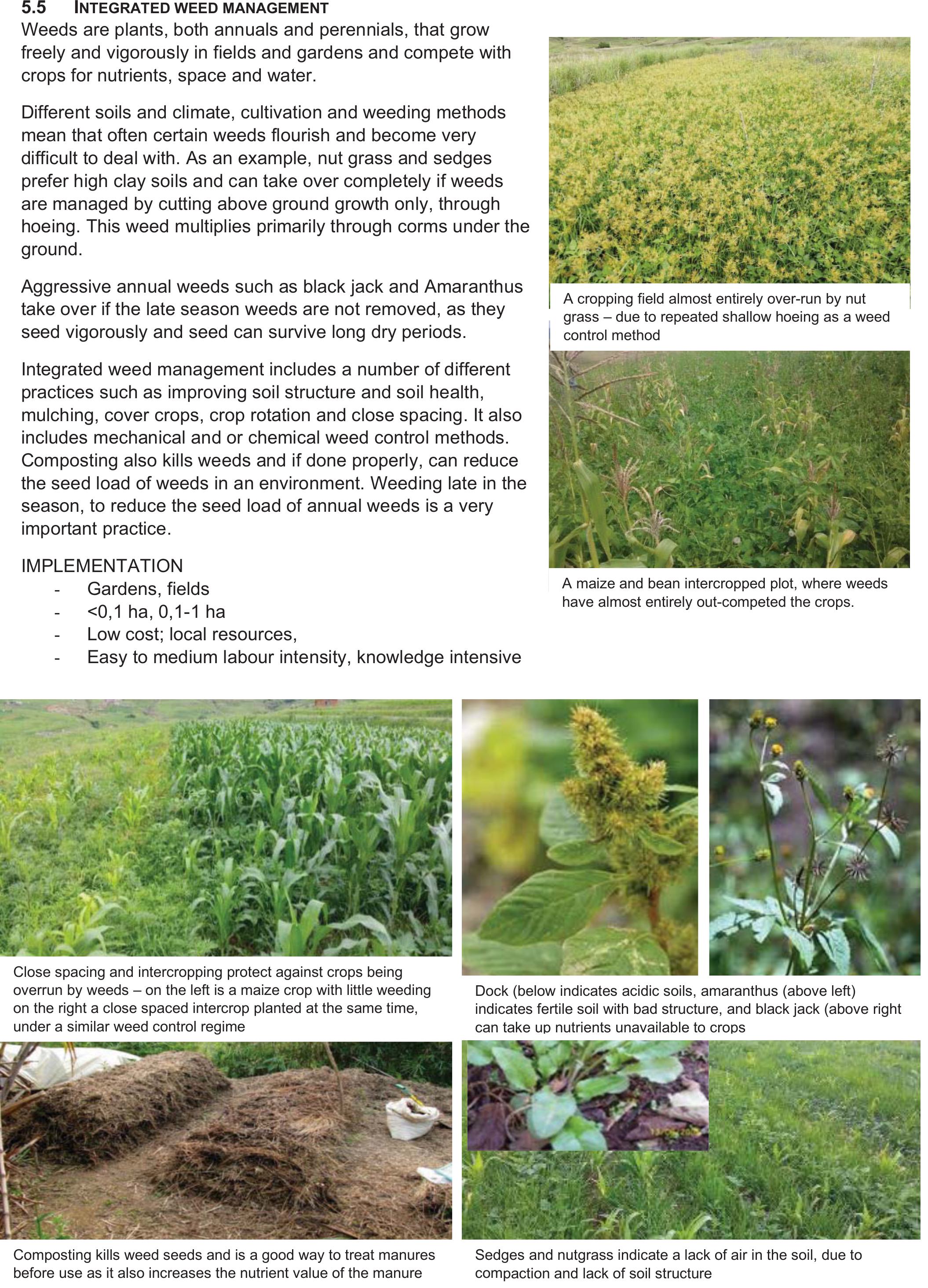
5.5 INTEGRATED WEED MANAGEMENT
Weeds are plants, both annuals and perennials, that grow
freely and vigorously in fields and gardens and compete with
crops for nutrients, space and water.
Different soils and climate, cultivation and weeding methods
mean that often certain weeds flourish and become very
difficult to deal with. As an example, nut grass and sedges
prefer high clay soils and can take over completely if weeds
are managed by cutting above ground growth only, through
hoeing. This weed multiplies primarily through corms under the
ground.
Aggressive annual weeds such as black jack and Amaranthus
take over if the late season weeds are not removed, as they
seed vigorously and seed can survive long dry periods.
Integrated weed management includes a number of different
practices such as improving soil structure and soil health,
mulching, cover crops, crop rotation and close spacing. It also
includes mechanical and or chemical weed control methods.
Composting also kills weeds and if done properly, can reduce
the seed load of weeds in an environment. Weeding late in the
season, to reduce the seed load of annual weeds is a very
important practice.
IMPLEMENTATION
- Gardens, fields
-<0,1 ha, 0,1-1 ha
-Low cost; local resources,
-Easy to medium labour intensity, knowledge intensive
A cropping field almost entirely over-run by nut
grass – due to repeated shallow hoeing as a weed
control method
A maize and bean intercropped plot, where weeds
have almost entirely out-competed the crops.
Composting kills weed seeds and is a good way to treat manures
before use as it also increases the nutrient value of the manure
Close spacing and intercropping protect against crops being
overrun by weeds – on the left is a maize crop with little weeding
on the right a close spaced intercrop planted at the same time,
under a similar weed control regime
Dock (below indicates acidic soils, amaranthus (above left)
indicates fertile soil with bad structure, and black jack (above right
can take u
p
nutrients unavailable to cro
p
s
Sedges and nutgrass indicate a lack of air in the soil, due to
com
p
action and lack of soil structure
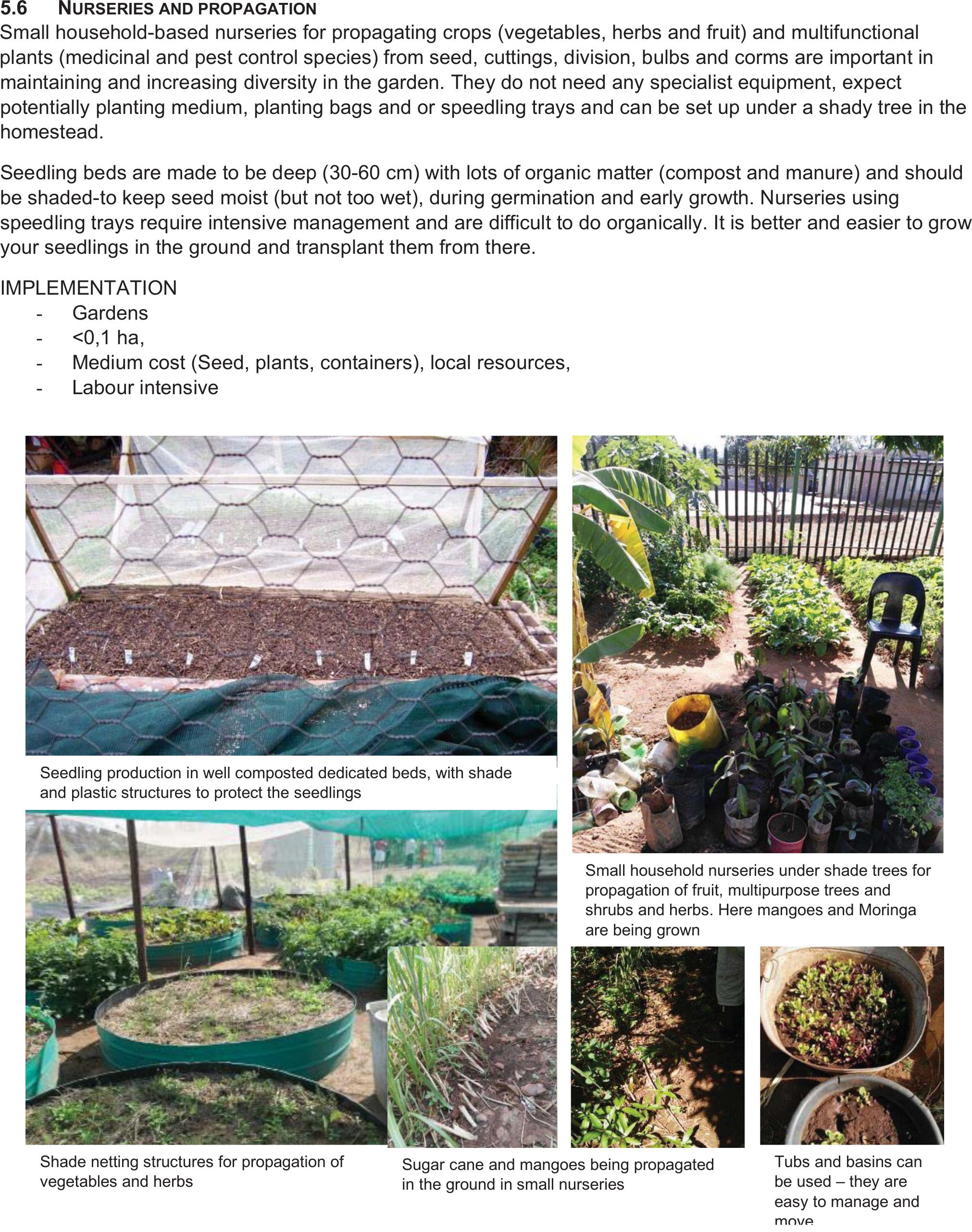
5.6 NURSERIES AND PROPAGATION
Small household-based nurseries for propagating crops (vegetables, herbs and fruit) and multifunctional
plants (medicinal and pest control species) from seed, cuttings, division, bulbs and corms are important in
maintaining and increasing diversity in the garden. They do not need any specialist equipment, expect
potentially planting medium, planting bags and or speedling trays and can be set up under a shady tree in the
homestead.
Seedling beds are made to be deep (30-60 cm) with lots of organic matter (compost and manure) and should
be shaded-to keep seed moist (but not too wet), during germination and early growth. Nurseries using
speedling trays require intensive management and are difficult to do organically. It is better and easier to grow
your seedlings in the ground and transplant them from there.
IMPLEMENTATION
- Gardens
-<0,1 ha,
-Medium cost (Seed, plants, containers), local resources,
- Labour intensive
Seedling production in well composted dedicated beds, with shade
and plastic structures to protect the seedlings
Shade netting structures for propagation of
vegetables and herbs
Tubs and basins can
be used – they are
easy to manage and
move
Sugar cane and mangoes being propagated
in the ground in small nurseries
Small household nurseries under shade trees for
propagation of fruit, multipurpose trees and
shrubs and herbs. Here mangoes and Moringa
are being grown

5.7 SEED SAVING
Seed saving is both a common practice among smallholders and a dwindling one. Seeds are kept from one
year to the next and due to increasingly difficult growing conditions, many participants have reported losing
most of their seed stock. Increasingly, smallholders will buy seed and attempt to keep seed from those crops
when harvested; meaning a substantial attrition in the availability of seed of traditional crops. Seed saving is a
very important practice for safe-guarding traditional crops and farmer preferred open pollinated varieties (not
hybrids), that are locally adapted to climate, pests and diseases.
Some aspects to keep in mind when saving seed are the following:
¾It is important to promote pollinators (insects that distribute pollen) by grow numerous types of
flowering plants and keep diversity in and around gardens and fields high and reducing pesticide use
¾Keep seed from strong healthy plants only; never from plants that are bolting (seeding early)
¾Choose between 6-24 plants to keep seed from
¾Never keep seed from diseased plants
¾Seed must mature and dry on the plant as long as possible and
¾Plants that easily cross pollinate need to be separated (e.g. brassicas, maize, peppers and chillies,
pumpkins, lettuce, etc.) in space, or time or use caging.
IMPLEMENTATION
- Gardens, fields,
-<0,1 ha, -0,1-1 ha, >2 ha
-Low cost, local resources
-Easy to do and maintain; somewhat labour and knowledge intensive
A garden for seed production, with structures for caging,
and 6-24 of each variety planted for seed saving –
different plant families are planted close together to
Hand pollination of maize for seed
selection
A caged chilli plant to ensure pure seed
that is true to type
Flowers and plants for promotion of
pollination; by bees, hornets, butterflies,
etc.
Pollinators
love flowers –
man
y
different
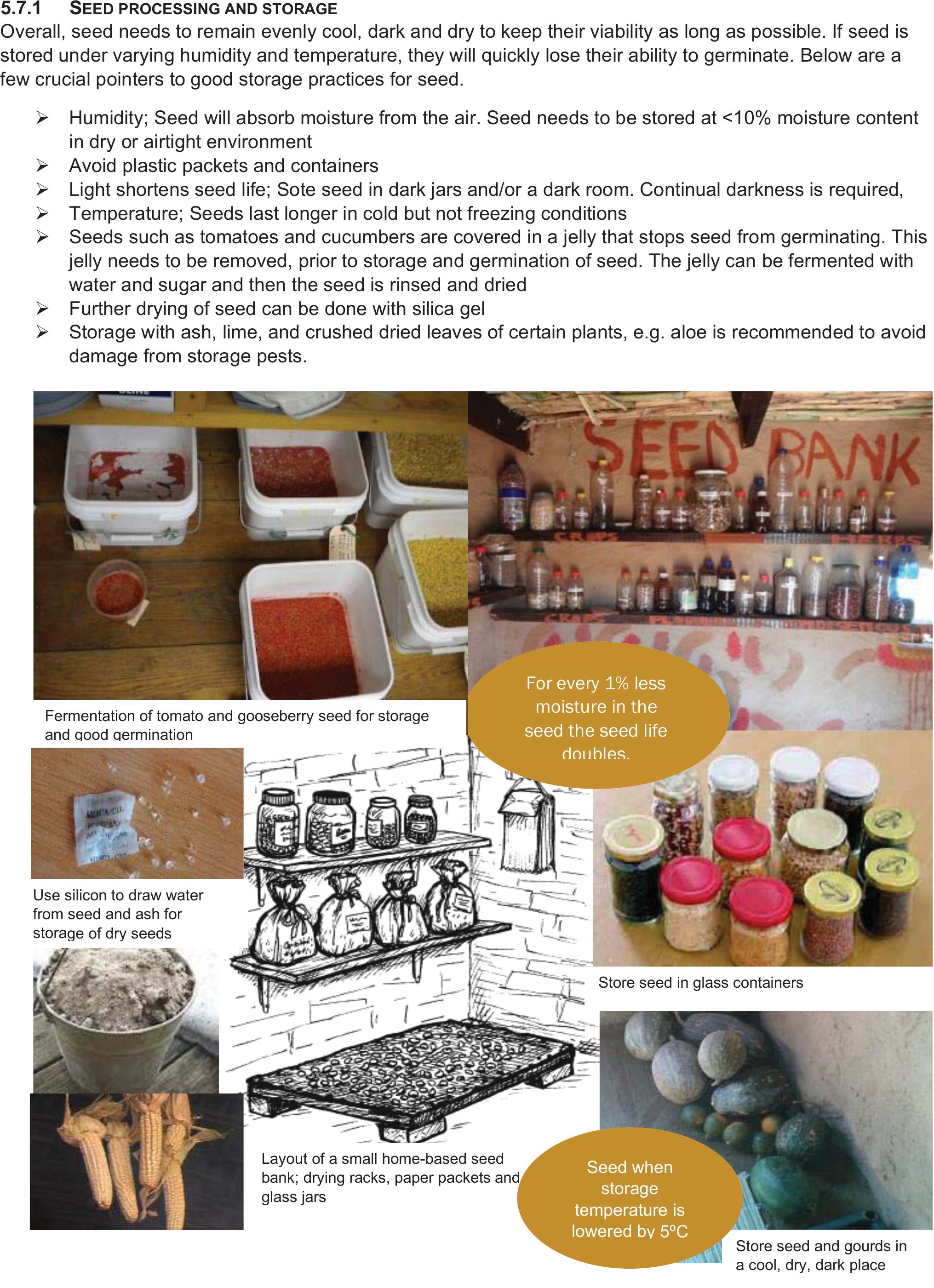
5.7.1 SEED PROCESSING AND STORAGE
Overall, seed needs to remain evenly cool, dark and dry to keep their viability as long as possible. If seed is
stored under varying humidity and temperature, they will quickly lose their ability to germinate. Below are a
few crucial pointers to good storage practices for seed.
¾Humidity; Seed will absorb moisture from the air. Seed needs to be stored at <10% moisture content
in dry or airtight environment
¾Avoid plastic packets and containers
¾Light shortens seed life; Sote seed in dark jars and/or a dark room. Continual darkness is required,
¾Temperature; Seeds last longer in cold but not freezing conditions
¾Seeds such as tomatoes and cucumbers are covered in a jelly that stops seed from germinating. This
jelly needs to be removed, prior to storage and germination of seed. The jelly can be fermented with
water and sugar and then the seed is rinsed and dried
¾Further drying of seed can be done with silica gel
¾Storage with ash, lime, and crushed dried leaves of certain plants, e.g. aloe is recommended to avoid
damage from storage pests.
For every 1% less
moisture in the
seed the seed life
doubles.
Use silicon to draw water
from seed and ash for
stora
g
e of dr
y
seeds
Layout of a small home-based seed
bank; drying racks, paper packets and
g
lass
j
ars
Store seed in glass containers
Fermentation of tomato and gooseberry seed for storage
and
g
ood
g
ermination
Store seed and gourds in
a cool, dry, dark place
Seed when
storage
temperature is
lowered b
y
5ºC
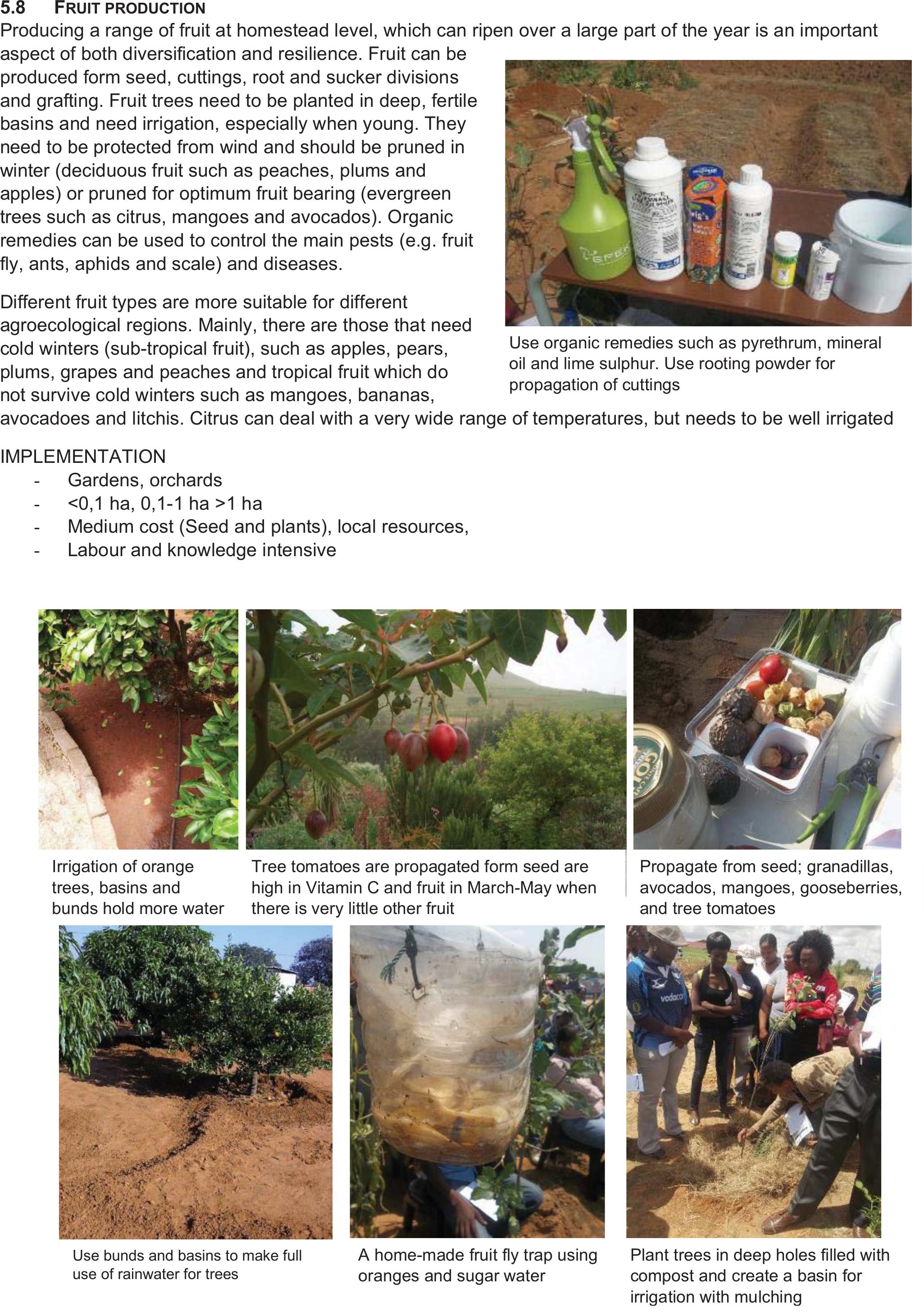
5.8 FRUIT PRODUCTION
Producing a range of fruit at homestead level, which can ripen over a large part of the year is an important
aspect of both diversification and resilience. Fruit can be
produced form seed, cuttings, root and sucker divisions
and grafting. Fruit trees need to be planted in deep, fertile
basins and need irrigation, especially when young. They
need to be protected from wind and should be pruned in
winter (deciduous fruit such as peaches, plums and
apples) or pruned for optimum fruit bearing (evergreen
trees such as citrus, mangoes and avocados). Organic
remedies can be used to control the main pests (e.g. fruit
fly, ants, aphids and scale) and diseases.
Different fruit types are more suitable for different
agroecological regions. Mainly, there are those that need
cold winters (sub-tropical fruit), such as apples, pears,
plums, grapes and peaches and tropical fruit which do
not survive cold winters such as mangoes, bananas,
avocadoes and litchis. Citrus can deal with a very wide range of temperatures, but needs to be well irrigated
IMPLEMENTATION
- Gardens, orchards
-<0,1 ha, 0,1-1 ha >1 ha
-Medium cost (Seed and plants), local resources,
-Labour and knowledge intensive
Use organic remedies such as pyrethrum, mineral
oil and lime sulphur. Use rooting powder for
propagation of cuttings
Irrigation of orange
trees, basins and
bunds hold more water
Tree tomatoes are propagated form seed are
high in Vitamin C and fruit in March-May when
there is very little other fruit
Propagate from seed; granadillas,
avocados, mangoes, gooseberries,
and tree tomatoes
Use bunds and basins to make full
use of rainwater for trees
A home-made fruit fly trap using
oranges and sugar water
Plant trees in deep holes filled with
compost and create a basin for
irri
g
ation with mulchin
g
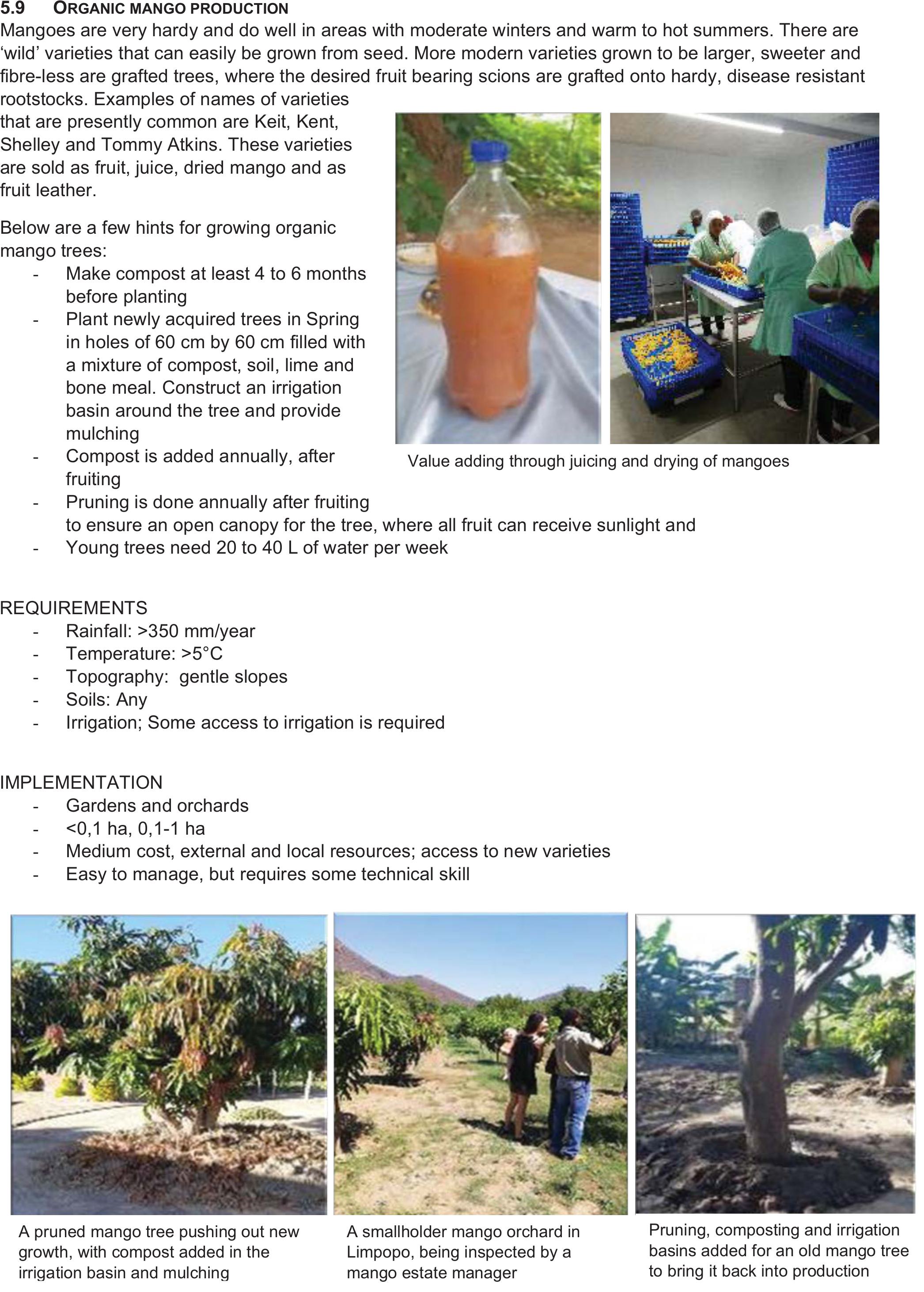
5.9 ORGANIC MANGO PRODUCTION
Mangoes are very hardy and do well in areas with moderate winters and warm to hot summers. There are
‘wild’ varieties that can easily be grown from seed. More modern varieties grown to be larger, sweeter and
fibre-less are grafted trees, where the desired fruit bearing scions are grafted onto hardy, disease resistant
rootstocks. Examples of names of varieties
that are presently common are Keit, Kent,
Shelley and Tommy Atkins. These varieties
are sold as fruit, juice, dried mango and as
fruit leather.
Below are a few hints for growing organic
mango trees:
-Make compost at least 4 to 6 months
before planting
-Plant newly acquired trees in Spring
in holes of 60 cm by 60 cm filled with
a mixture of compost, soil, lime and
bone meal. Construct an irrigation
basin around the tree and provide
mulching
-Compost is added annually, after
fruiting
-Pruning is done annually after fruiting
to ensure an open canopy for the tree, where all fruit can receive sunlight and
-Young trees need 20 to 40 L of water per week
REQUIREMENTS
- Rainfall: >350 mm/year
- Temperature: >5°C
-Topography: gentle slopes
- Soils: Any
-Irrigation; Some access to irrigation is required
IMPLEMENTATION
-Gardens and orchards
-<0,1 ha, 0,1-1 ha
-Medium cost, external and local resources; access to new varieties
-Easy to manage, but requires some technical skill
Value adding through juicing and drying of mangoes
A pruned mango tree pushing out new
growth, with compost added in the
irri
g
ation basin and mulchin
g
A smallholder mango orchard in
Limpopo, being inspected by a
mango estate manager
Pruning, composting and irrigation
basins added for an old mango tree
to bring it back into production

6 LIVESTOCK INTEGRATION
These are aspects of livestock management which either overlap with cropping and or are part of integrating
the farming system into one coherent system.
In this section we explore practices that can increase and improve fodder and grazing options for livestock
6.1 AGROFORESTRY OPTIONS
Tree crops are mixed into the farming system either as fallows, monocrops or between annual crops (usually
as strip cropping in rows). Livestock fodder species such as pigeon pea (udali), acacia species
(umhlalankwazi), Sesbani sesban (umsokosoko), Moringa olifeara and Leauceana spp are common.
REQUIREMENTS
- Rainfall: >350 mm/year
- Temperature: >5°C
- Topography: 1,5&-15%
- Soil: all types
IMPLEMENTATION
- Gardens, fields
-<0,1 ha, 0,1-1 ha, >2 ha
-Medium cost (Seed/planting stock), local resources
- Labour intensive
Goats grazing on a stand of pigeon peas
Moringas planted in lines in a small field Leaucena hedgerow in a field planted to beans
(foreground) and maize (background)
Sesbania plant growing in a field as a hedgerow
Examples of different ways of planting trees in a landscape
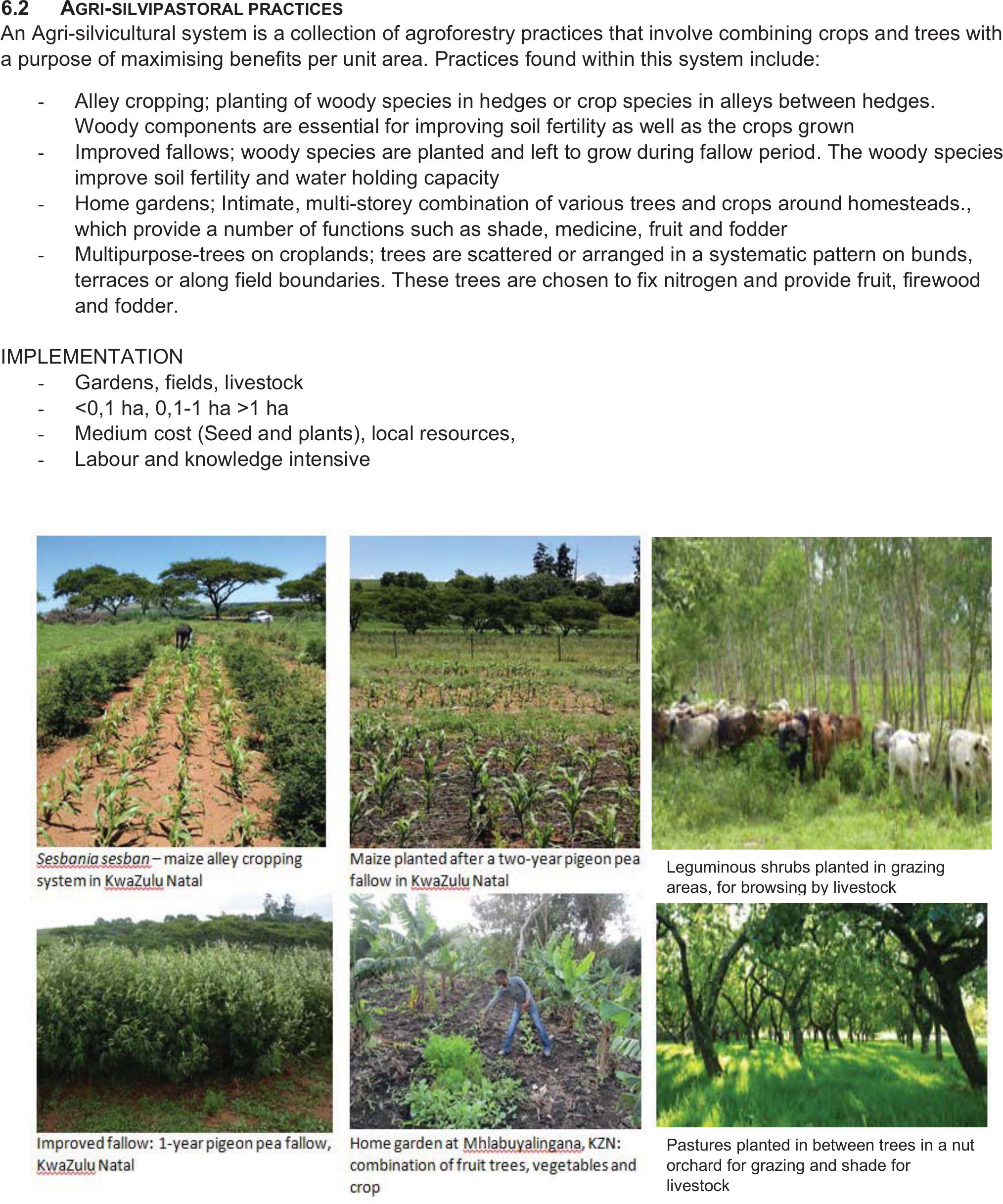
6.2 AGRI-SILVIPASTORAL PRACTICES
An Agri-silvicultural system is a collection of agroforestry practices that involve combining crops and trees with
a purpose of maximising benefits per unit area. Practices found within this system include:
-Alley cropping; planting of woody species in hedges or crop species in alleys between hedges.
Woody components are essential for improving soil fertility as well as the crops grown
-Improved fallows; woody species are planted and left to grow during fallow period. The woody species
improve soil fertility and water holding capacity
-Home gardens; Intimate, multi-storey combination of various trees and crops around homesteads.,
which provide a number of functions such as shade, medicine, fruit and fodder
-Multipurpose-trees on croplands; trees are scattered or arranged in a systematic pattern on bunds,
terraces or along field boundaries. These trees are chosen to fix nitrogen and provide fruit, firewood
and fodder.
IMPLEMENTATION
-Gardens, fields, livestock
-<0,1 ha, 0,1-1 ha >1 ha
-Medium cost (Seed and plants), local resources,
-Labour and knowledge intensive
Leguminous shrubs planted in grazing
areas
,
for browsin
g
b
y
livestock
Pastures planted in between trees in a nut
orchard for grazing and shade for
livestock

6.3 CREEP FEEDING AND SUPPLEMENTATION
Supplementary feeding is a livestock management practice used to provide animals with those nutrients that
the pastures lack. This is important in winter, when there is a lack of grazing and also if grazing quality is low
(i.e. has little to no protein) Options for supplementary feeding include:
-Protein meals and liquids such as Voermol Premix 450 (a powder) and LS 33 (a liquid)
-Grain and seed such as crushed maize, sorghum, etc.
-Lick blocks; both mineral and protein licks
Supplementation can also be in a form of alternative fodder species. This involves growing of species with
higher/better nutritional value compared to present fodder. Most of these species are planted to provide high
quality green fodder into late winter. Examples of these species include: Lucerne, fodder rye, black (saia)
oats, vetch, Teff, fodder radish, Japanese radish, Kale, and turnips. Perennial grass species that remain
green into winter such as kikuyu and Tall Fescue as also a good idea
Creep feeding is a simple management practice allowing calves unrestricted access to additional feed while
they are still suckling the cow. Calves gain access to the feed supplement through a 'creep', which is a fence
opening or a gate opening large enough for calves to pass through but too small for the cows.
IMPLEMENTATION
- Livestock
-0,1-1 ha >1 ha
-Medium cost, local resources,
-Labour and knowledge intensive

A fodder supplement made from Dried Sesbania
sesban leaves, crushed maize and salt
An example of a commercial creep feeding mechanism for
calves.
Japanese radish
A relay crop of vetch and Saia oats into a field of maize for winter grazing.
LS 33 and premix 450
Home-made protein lick blocks consisting of molasses, urea
protein meal, a phosphorous source, water, a bit of cement and
salt.

6.4 STALL FEEDING AND HAY MAKING
Stall feeding is basically a cut and carry system of feeding livestock in their stalls/kraals, to reduce damage
caused by livestock in fields and also to ensure better nutrition.
Hay is dried livestock feed and can
be made from veld grass, specific
species such as Lucerne, cowpeas,
Teff, etc. or crop residues. Hay
bales can be made on a small scale
with a hand operated baler,
appropriate for smallholder farmers.
IMPLEMENTATION
- Livestock
-0,1-1 ha >1 ha
-Medium cost, local resources,
-Labour and knowledge intensive
Lucerne bale Eragrostis Teff bale
Hand operated baler, with a bale of veld grass made with this baler
Stall or kraal feeding
Legume (soy bean) stover
Maize stover
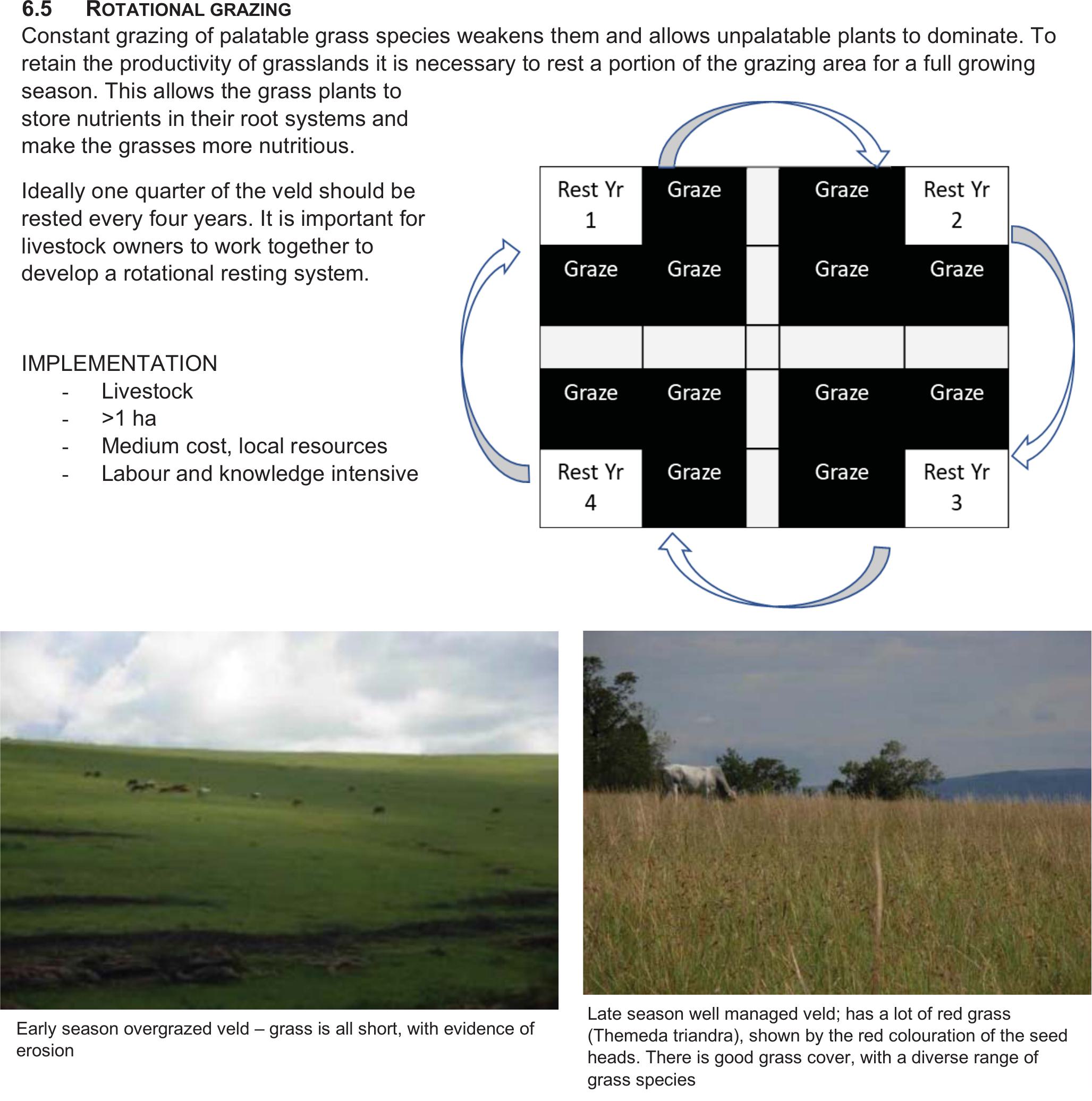
6.5 ROTATIONAL GRAZING
Constant grazing of palatable grass species weakens them and allows unpalatable plants to dominate. To
retain the productivity of grasslands it is necessary to rest a portion of the grazing area for a full growing
season. This allows the grass plants to
store nutrients in their root systems and
make the grasses more nutritious.
Ideally one quarter of the veld should be
rested every four years. It is important for
livestock owners to work together to
develop a rotational resting system.
IMPLEMENTATION
- Livestock
- >1 ha
-Medium cost, local resources
-Labour and knowledge intensive
Early season overgrazed veld – grass is all short, with evidence of
erosion
Late season well managed veld; has a lot of red grass
(Themeda triandra), shown by the red colouration of the seed
heads. There is good grass cover, with a diverse range of
grass species
